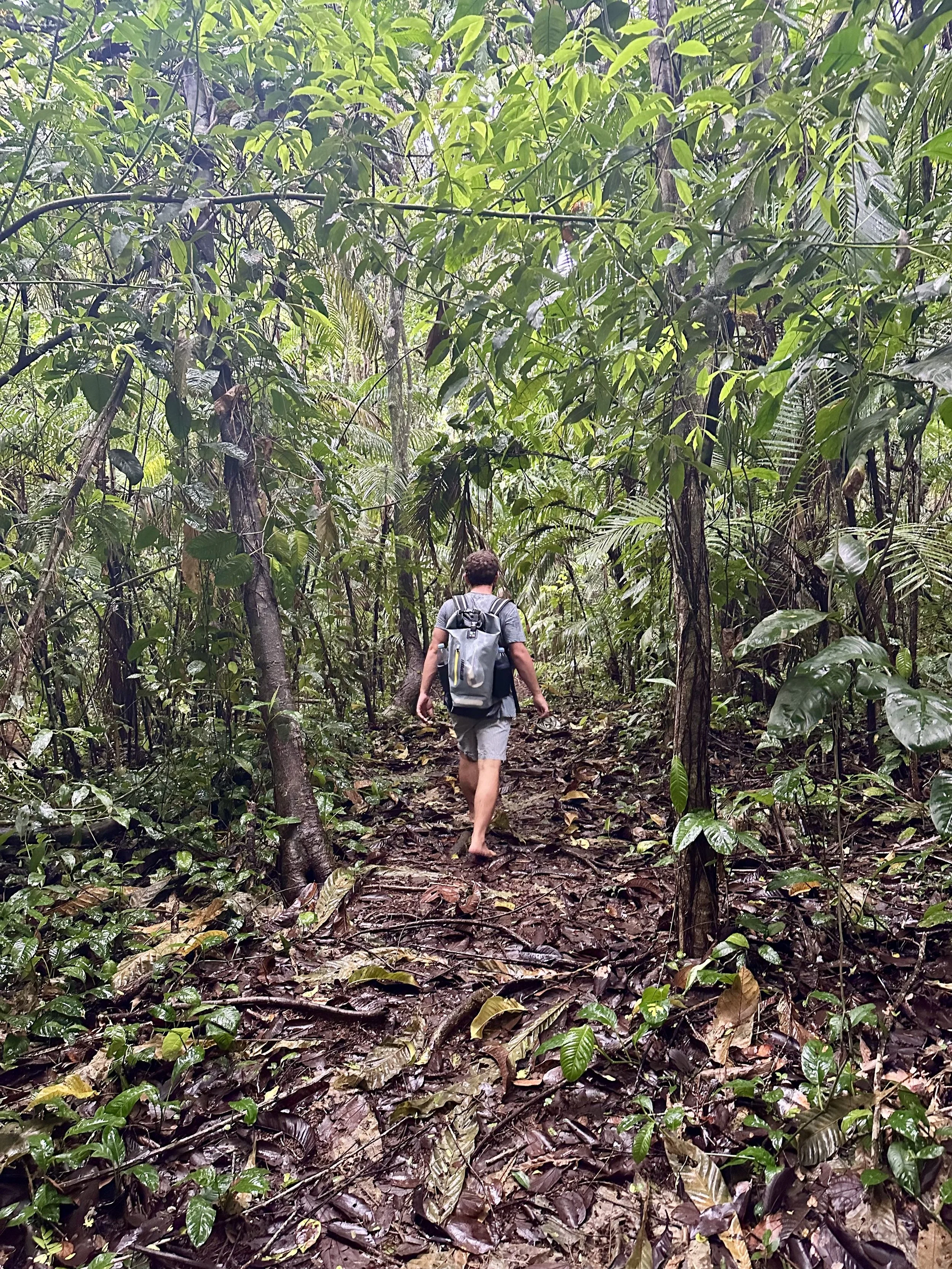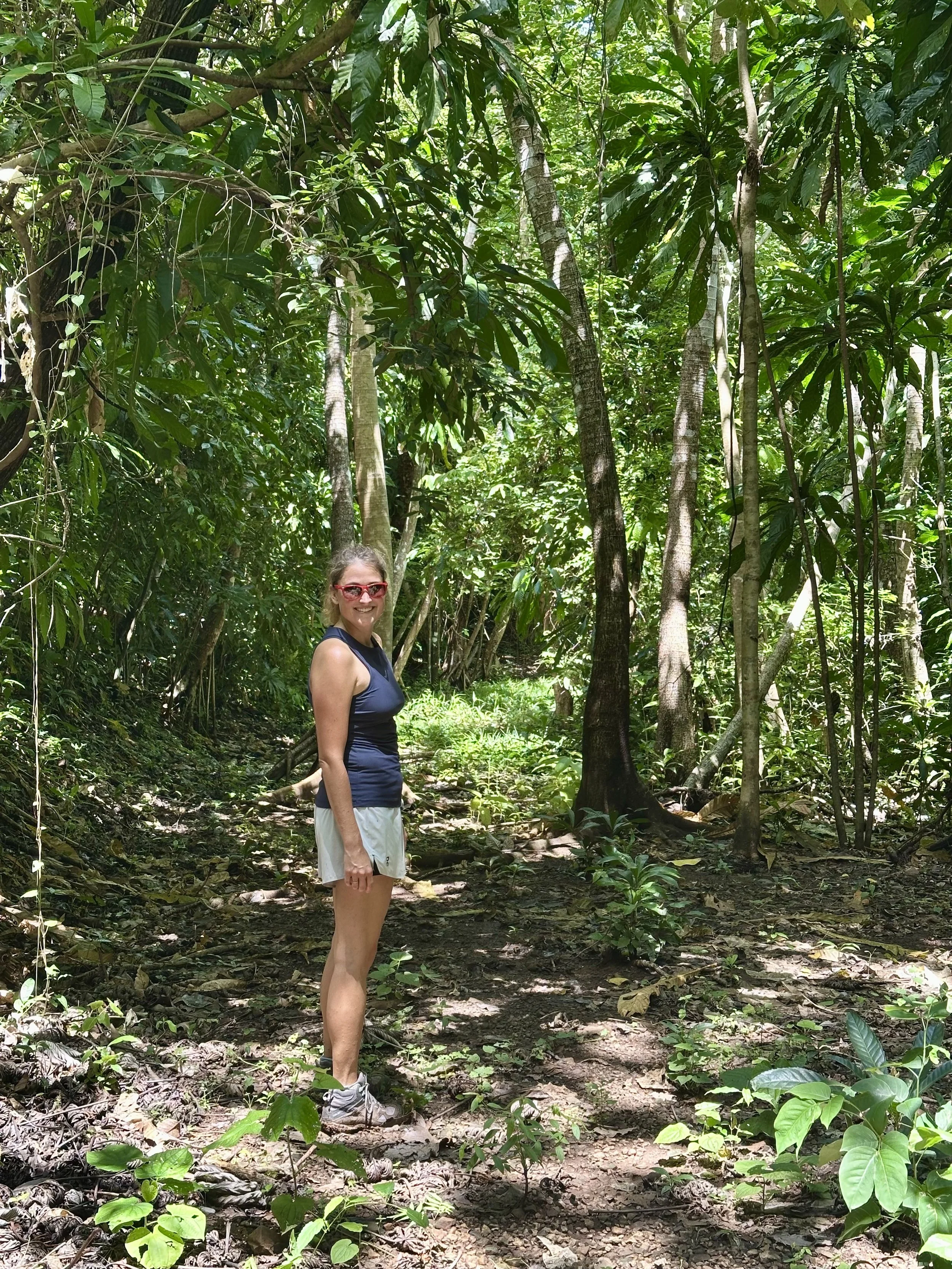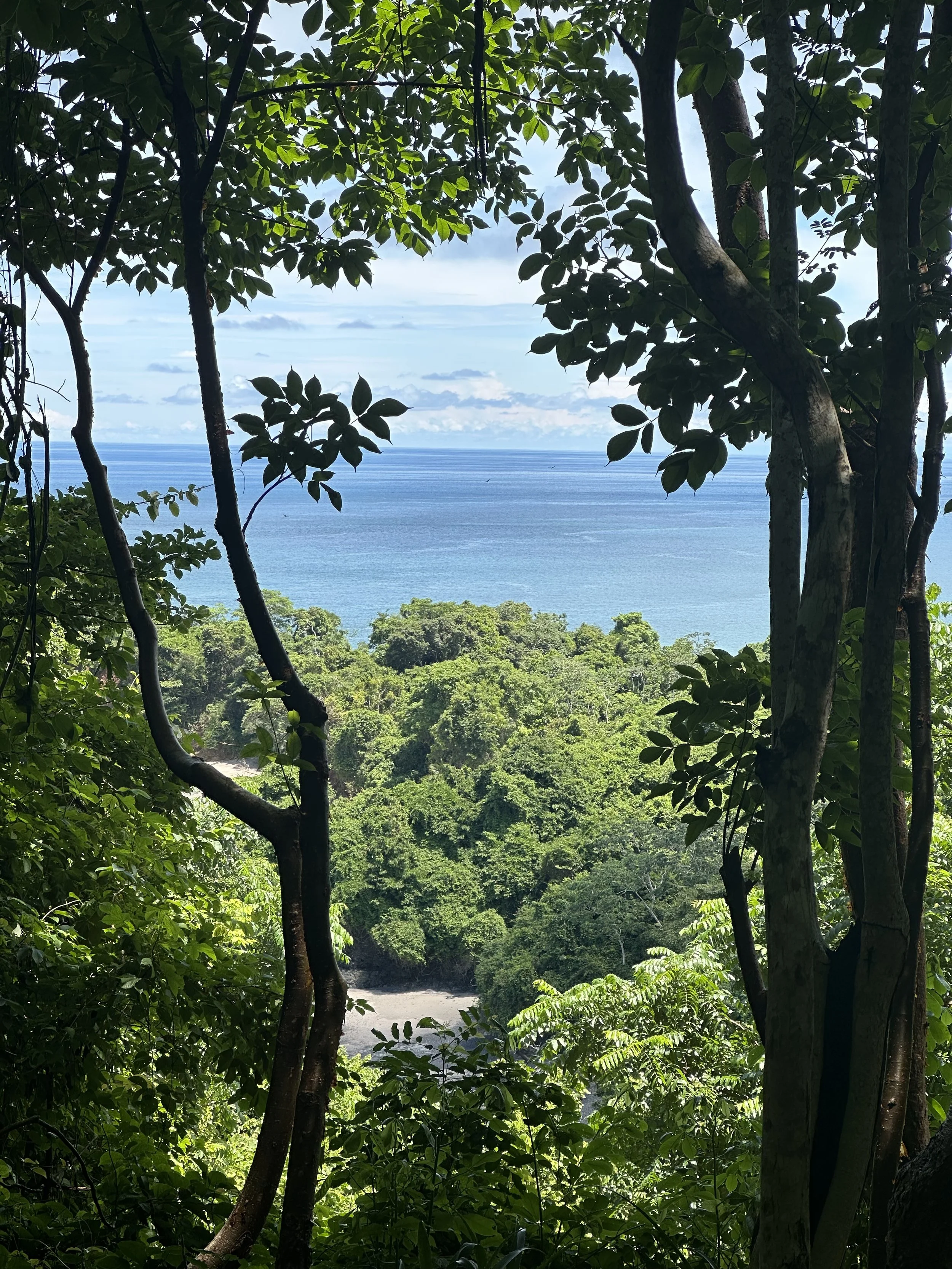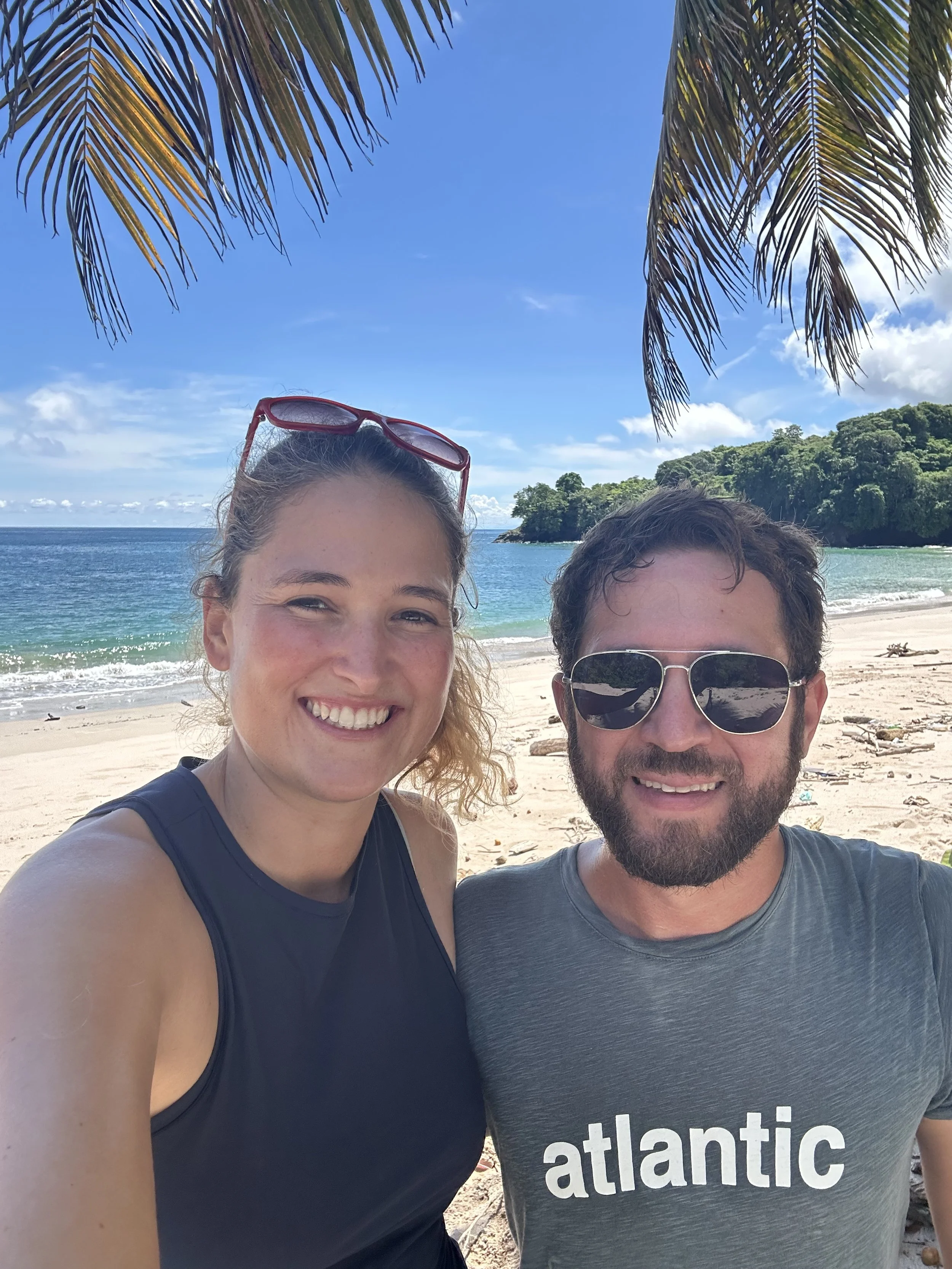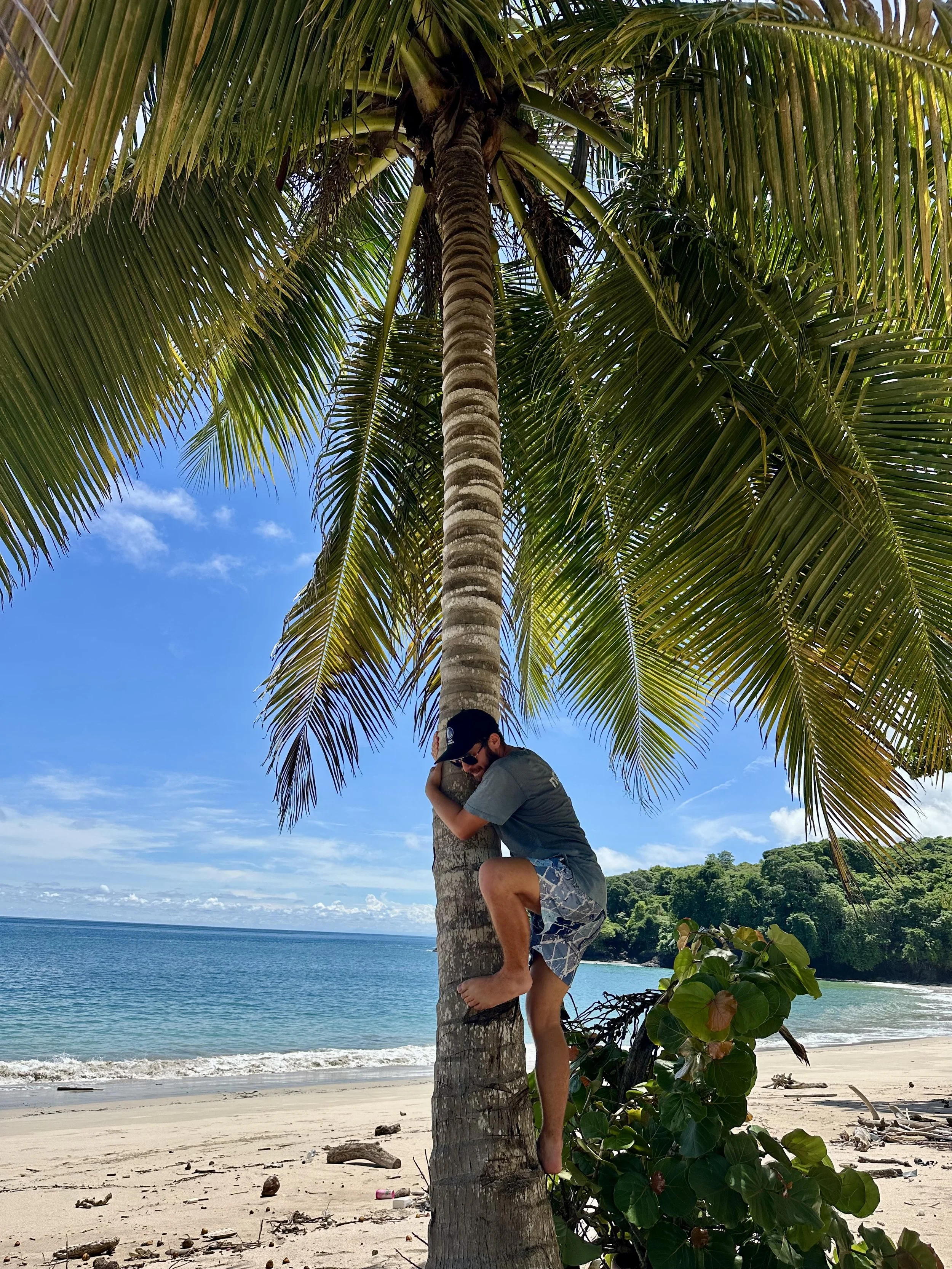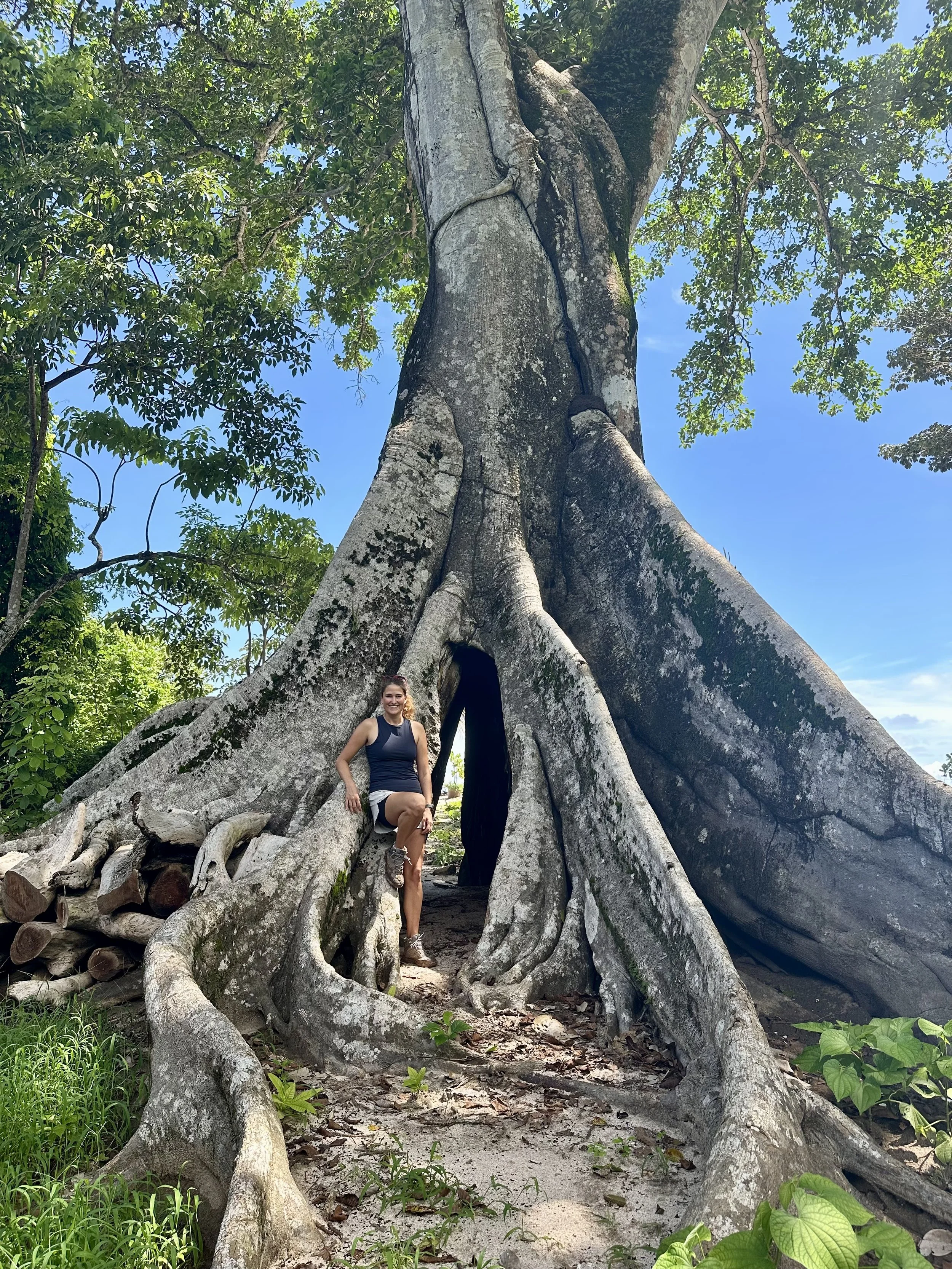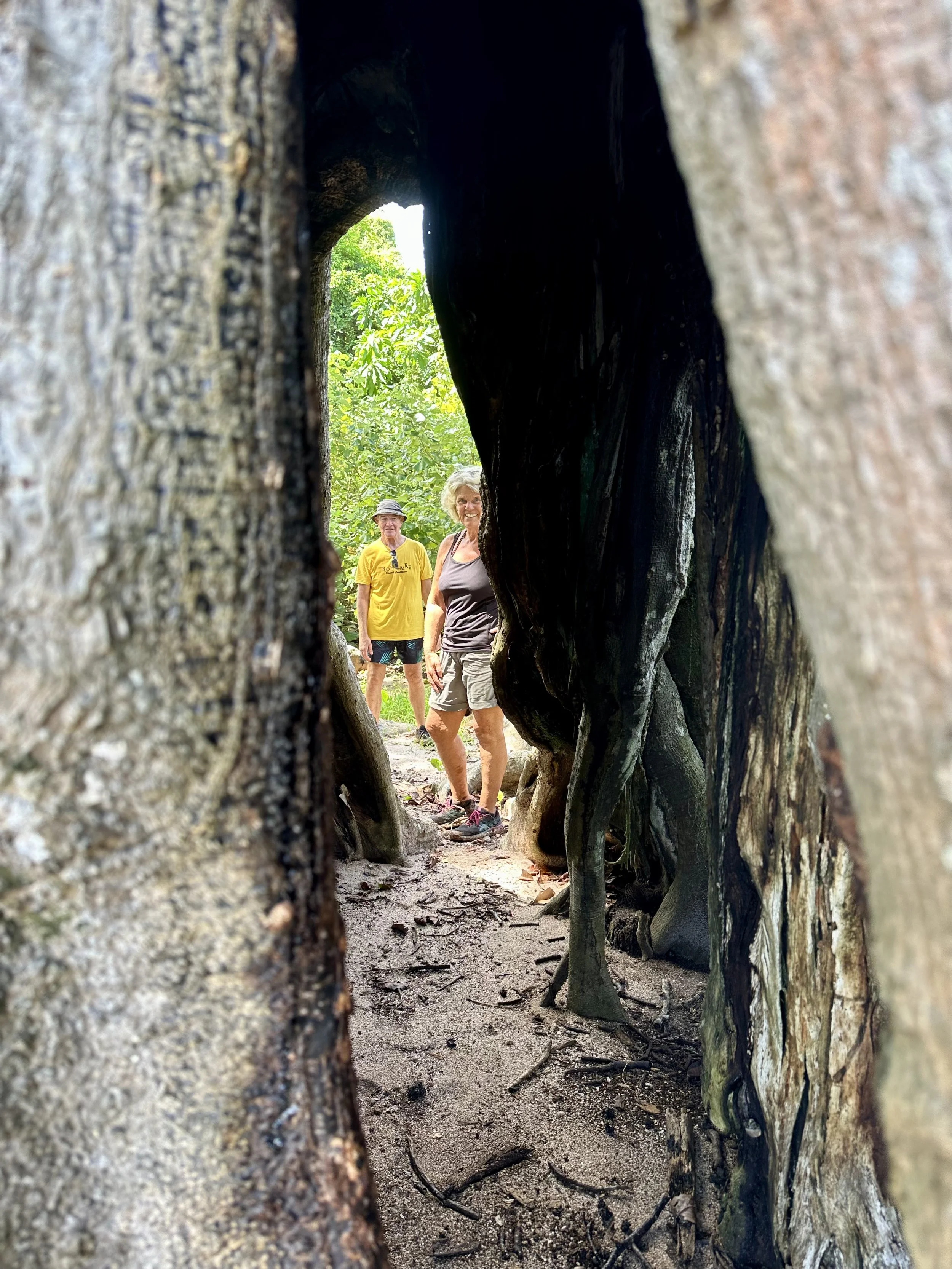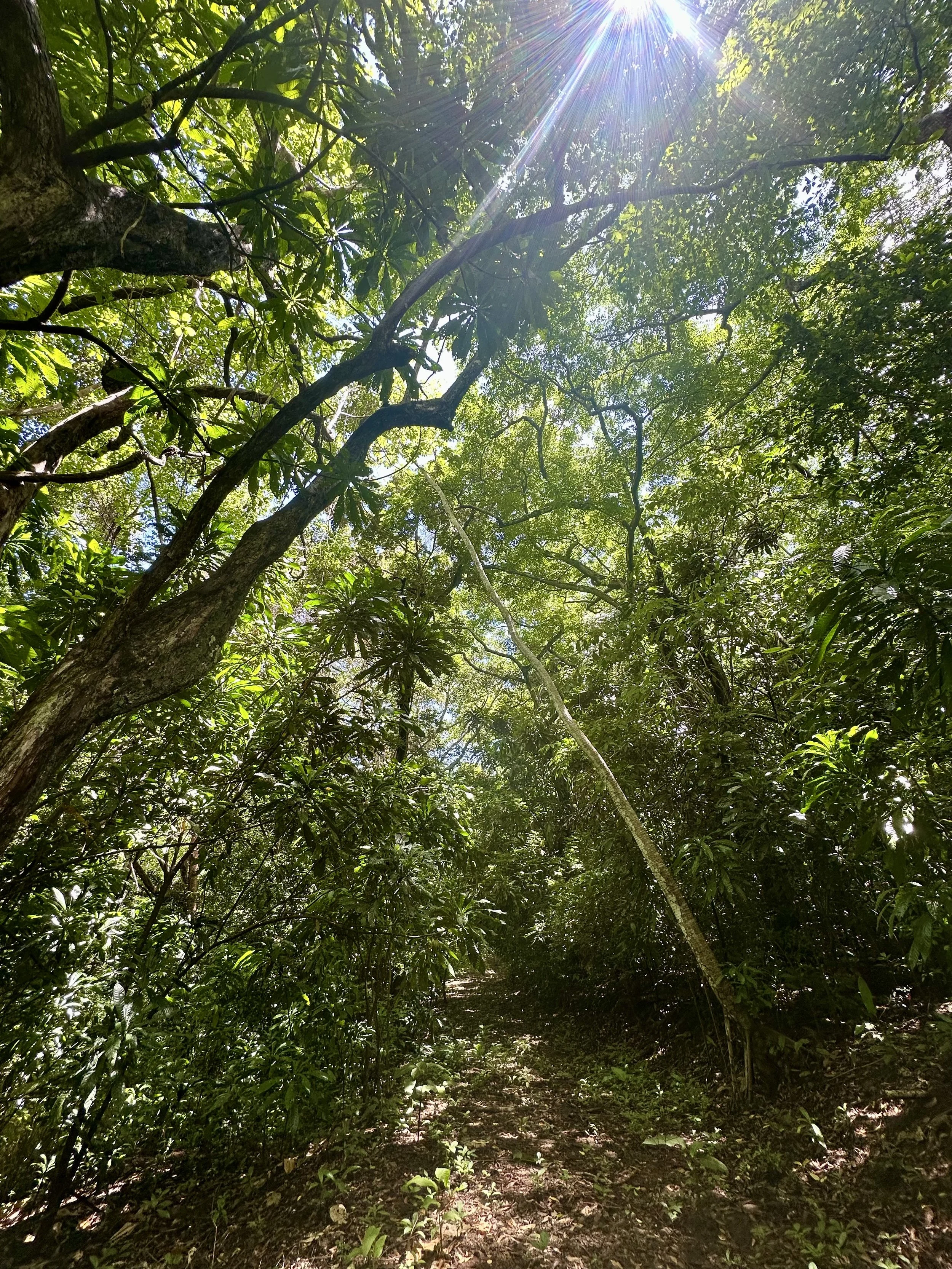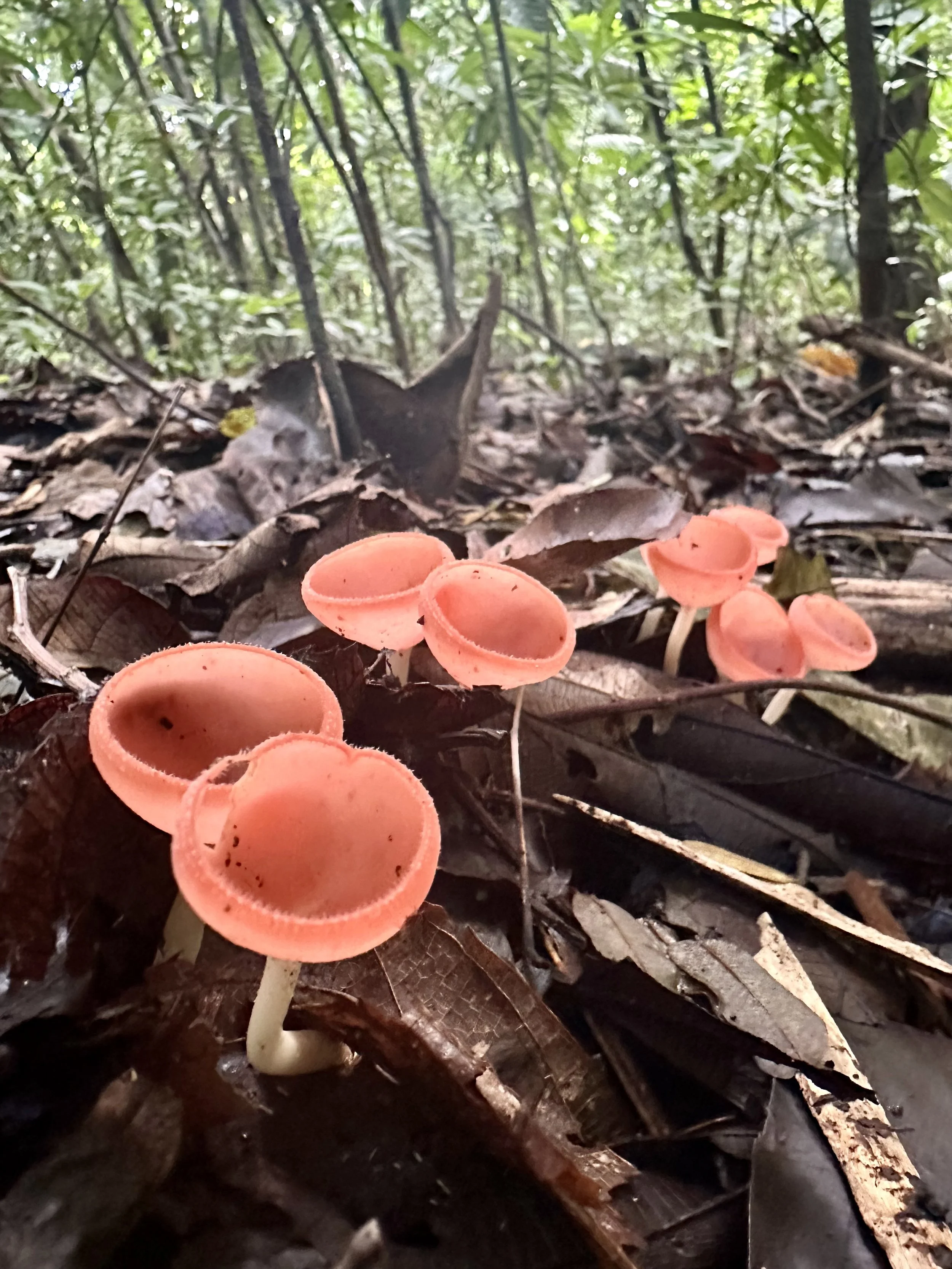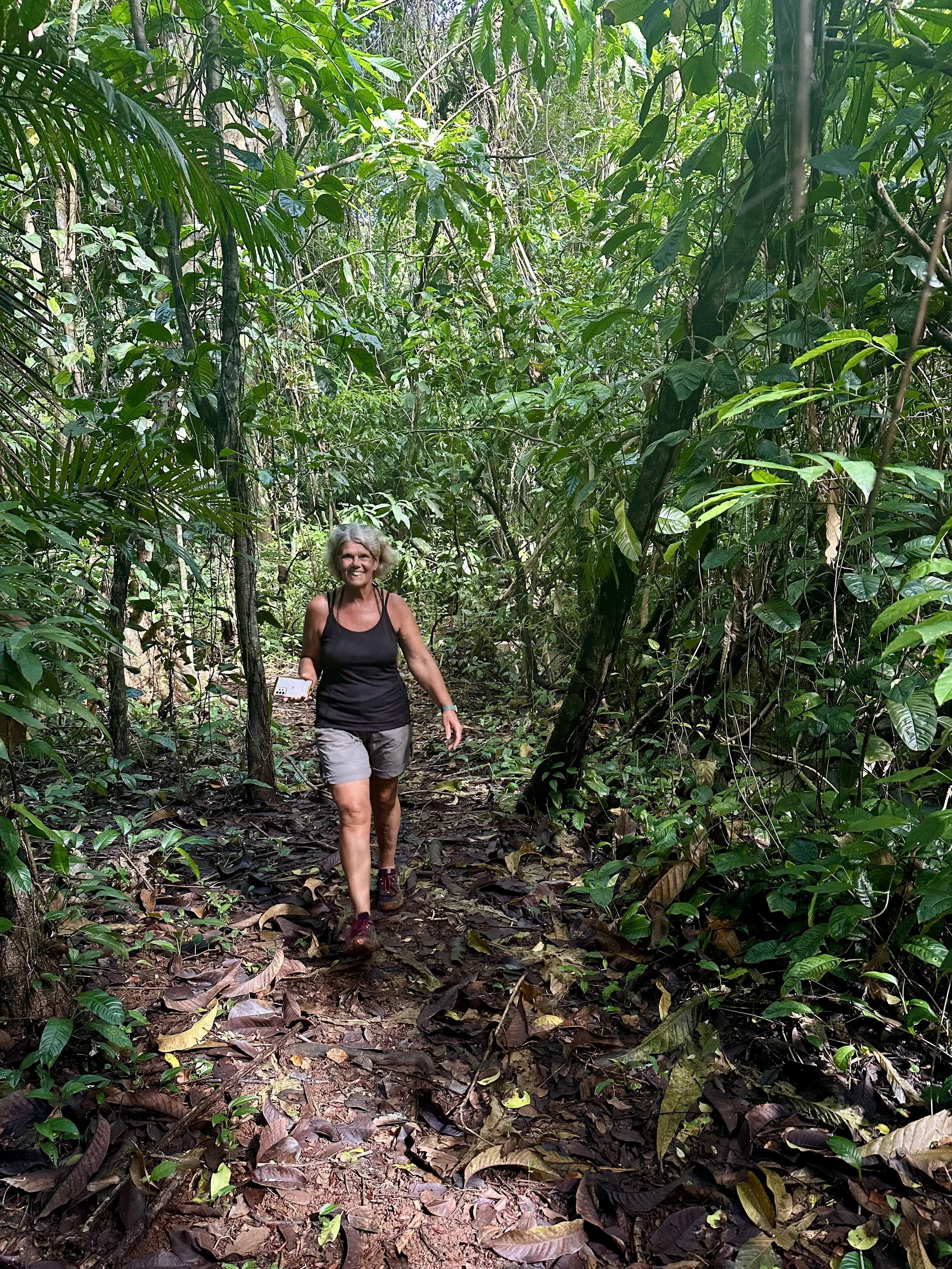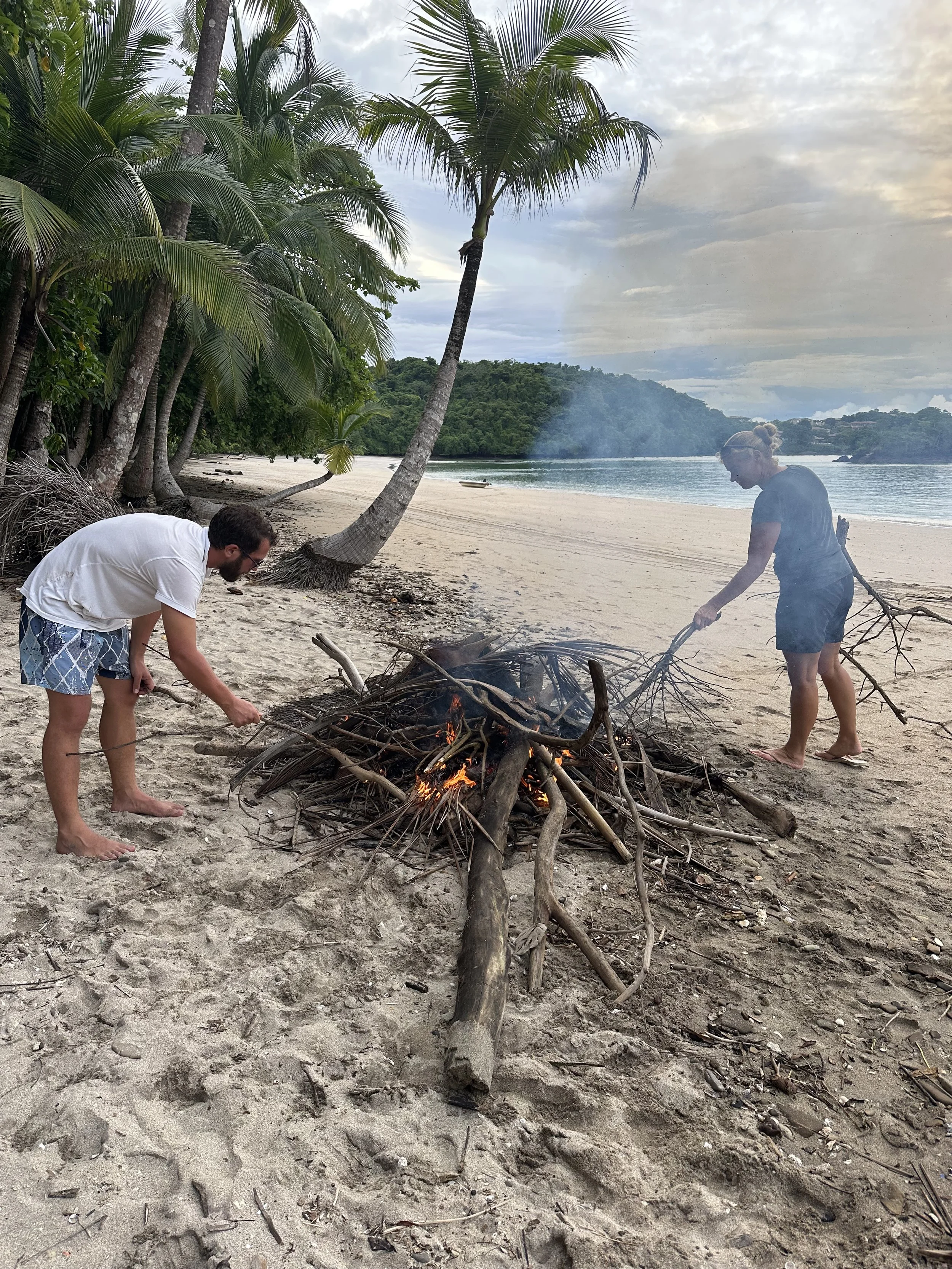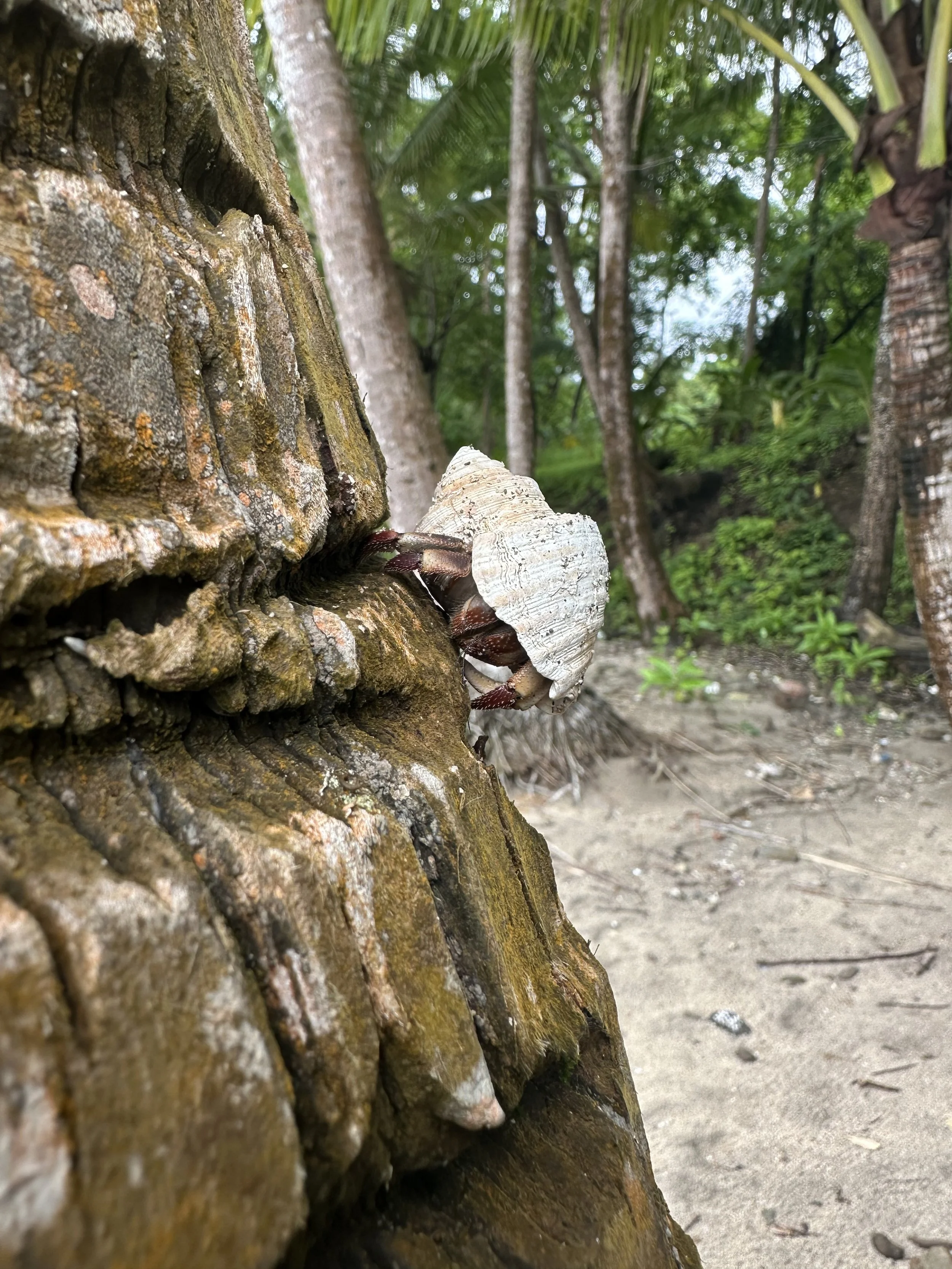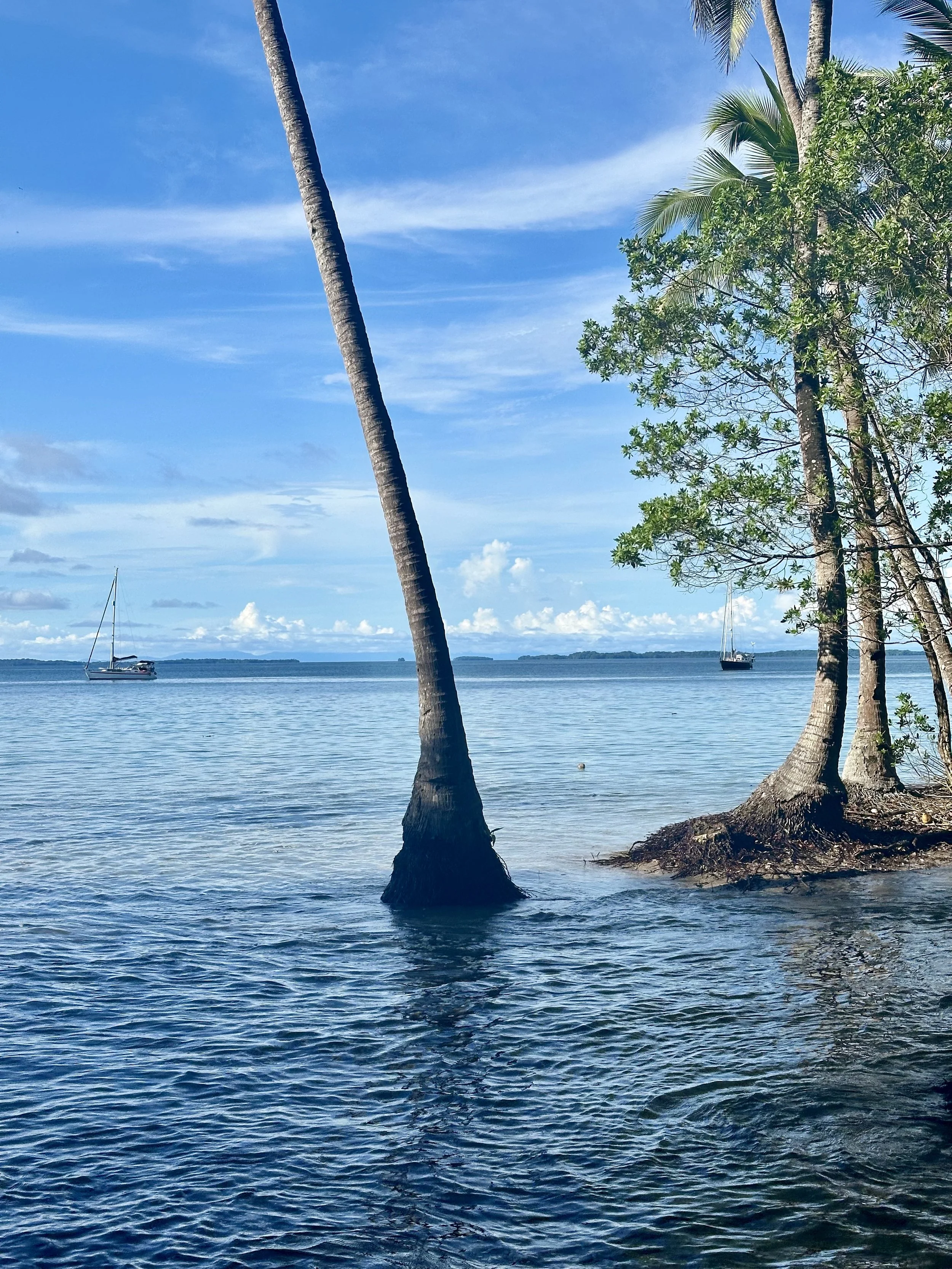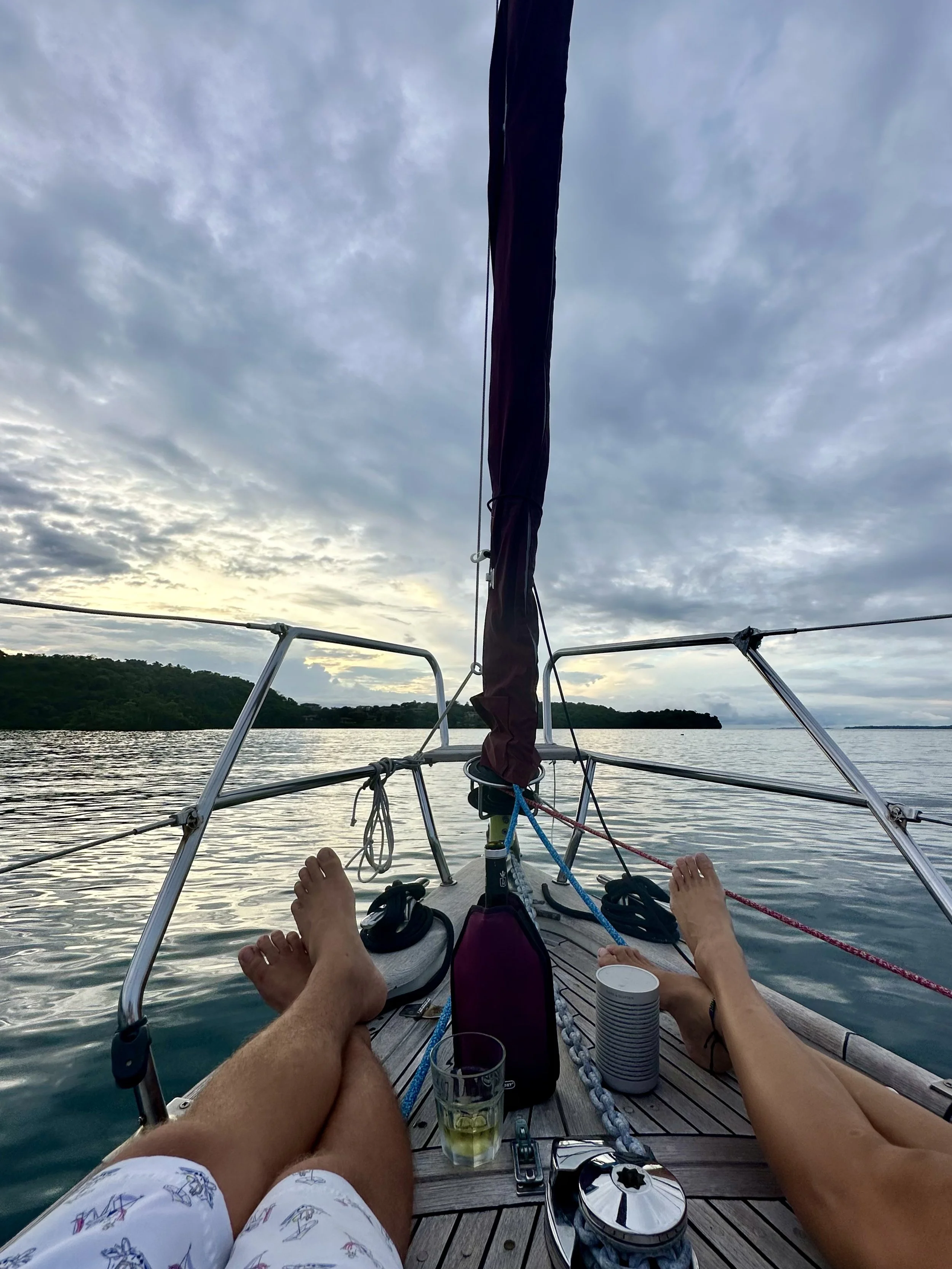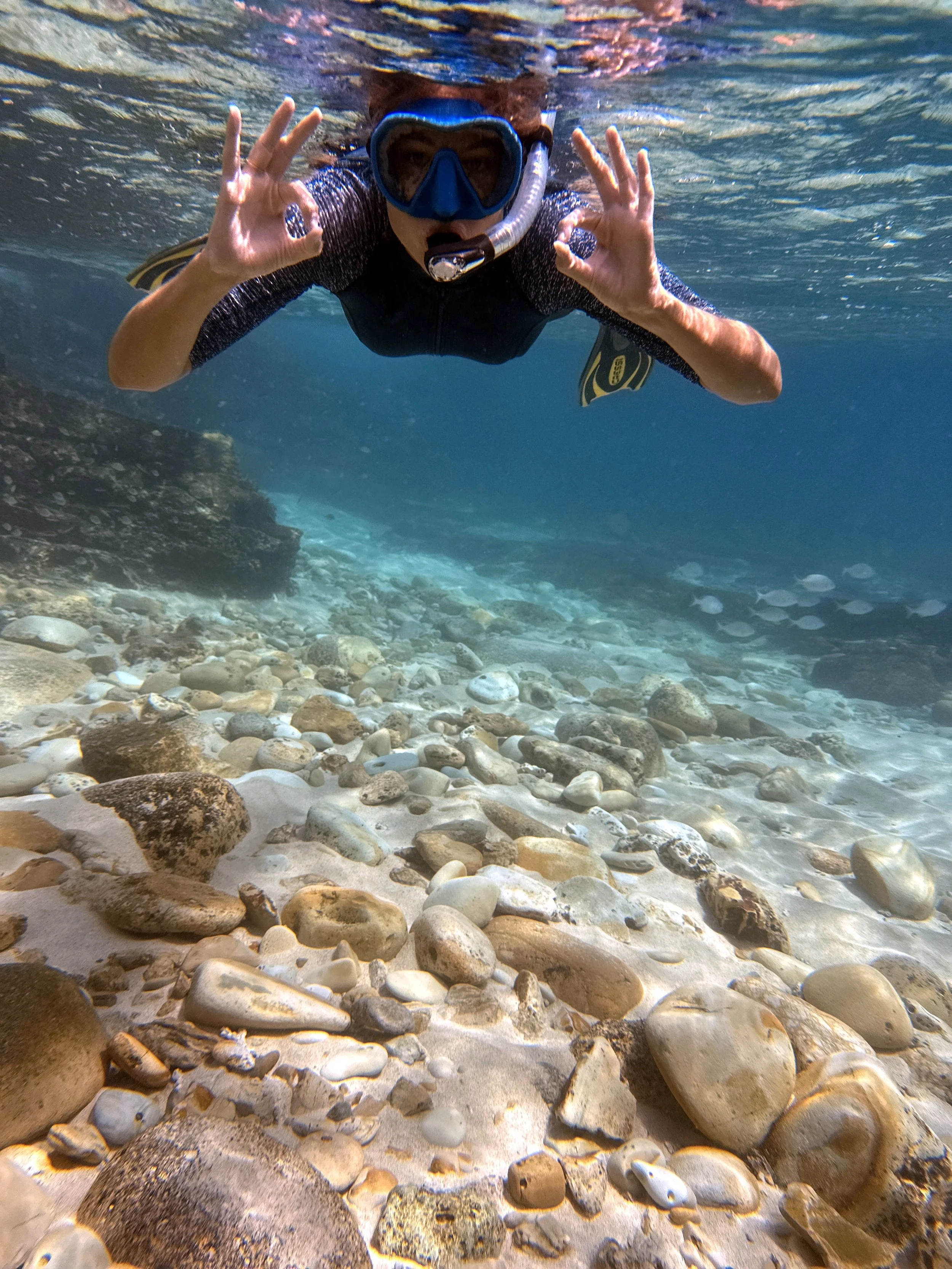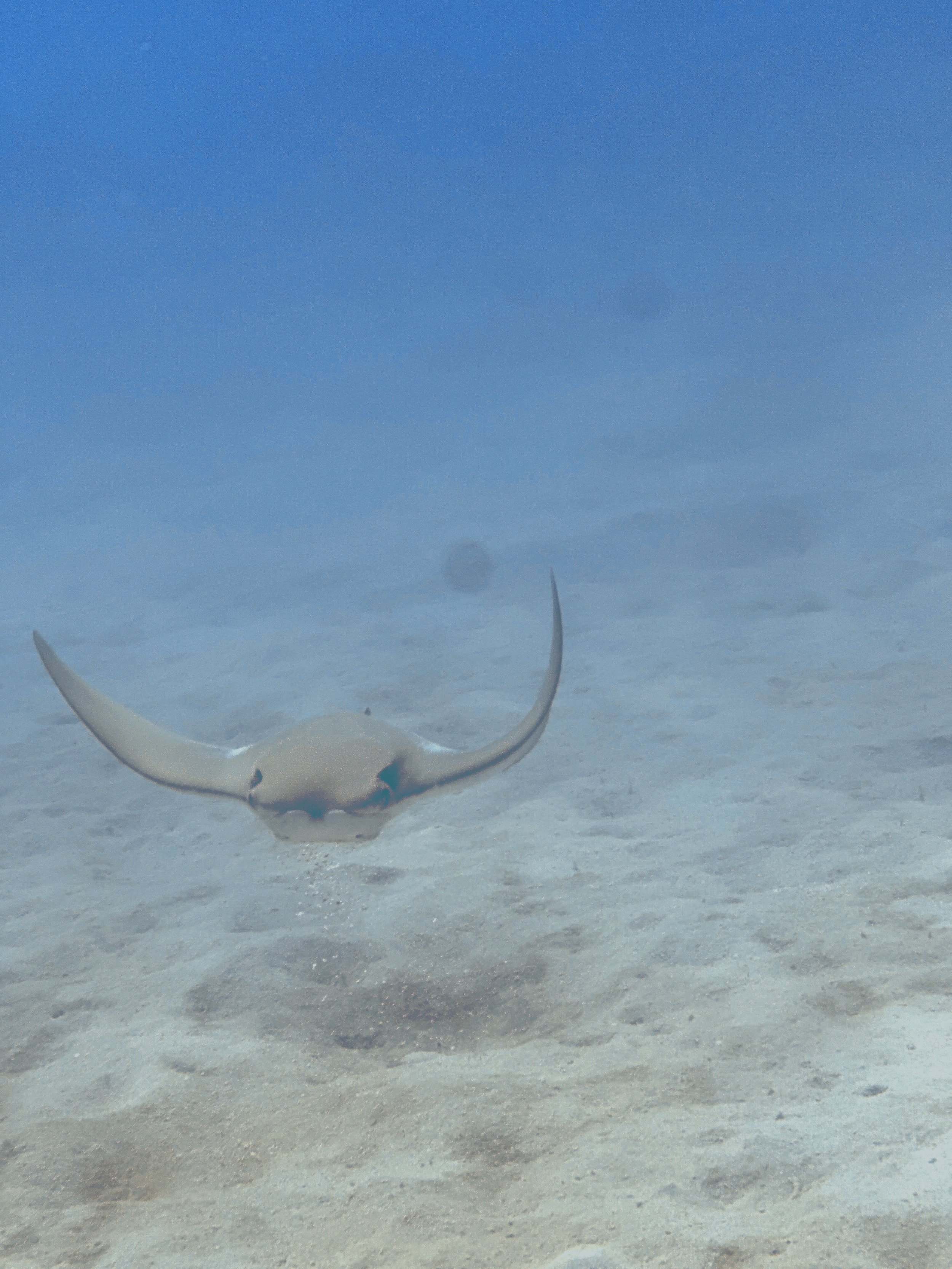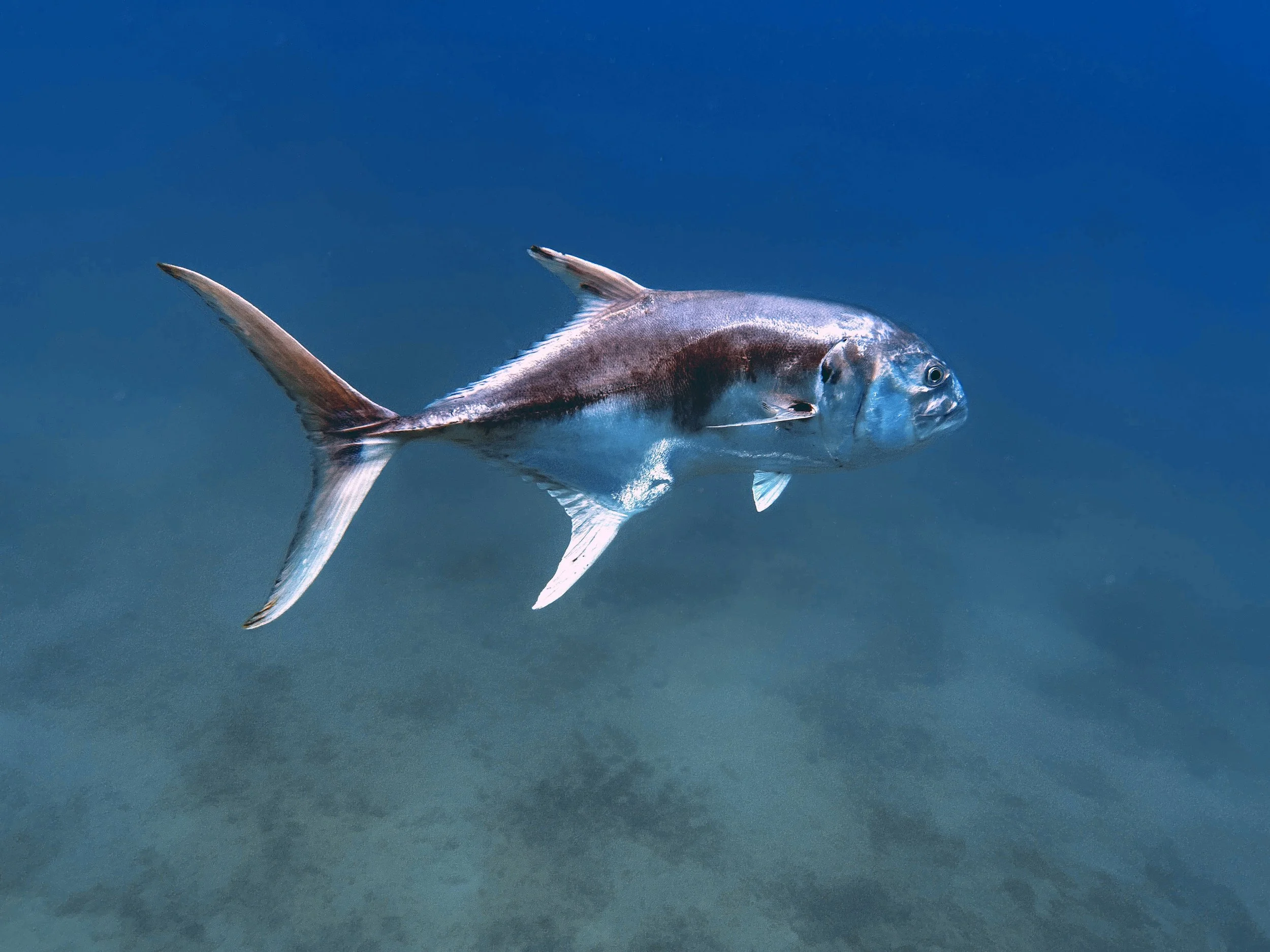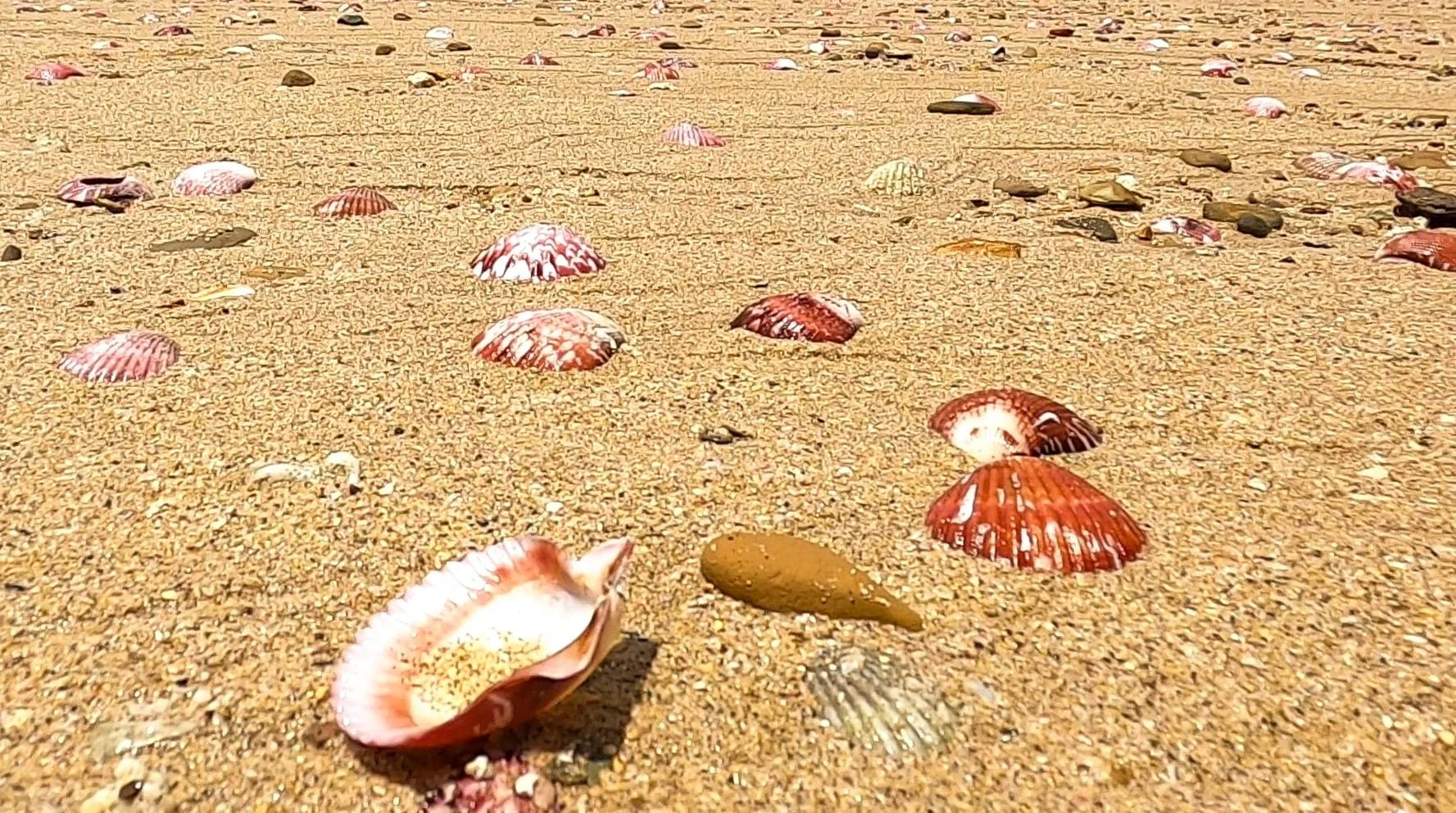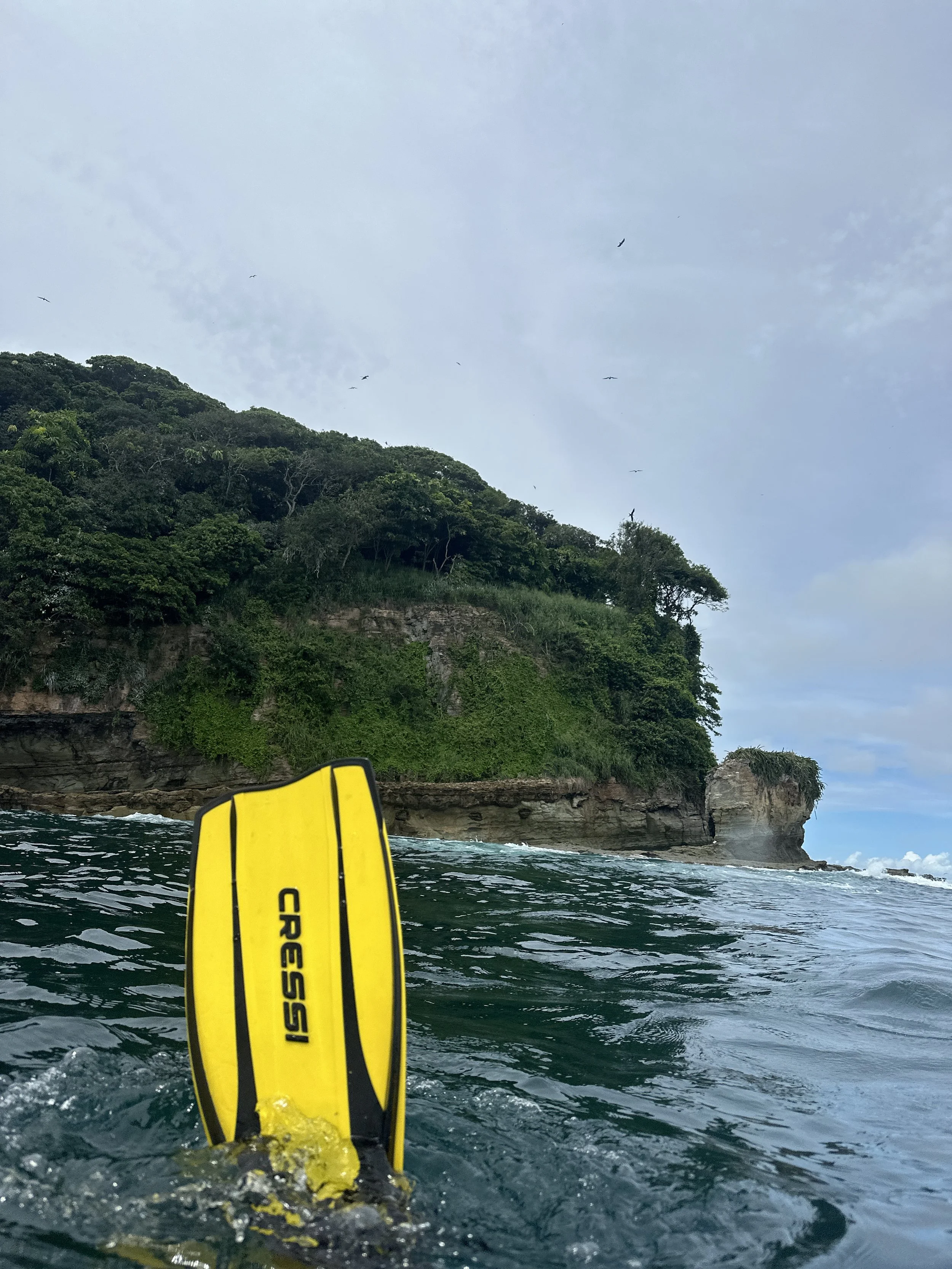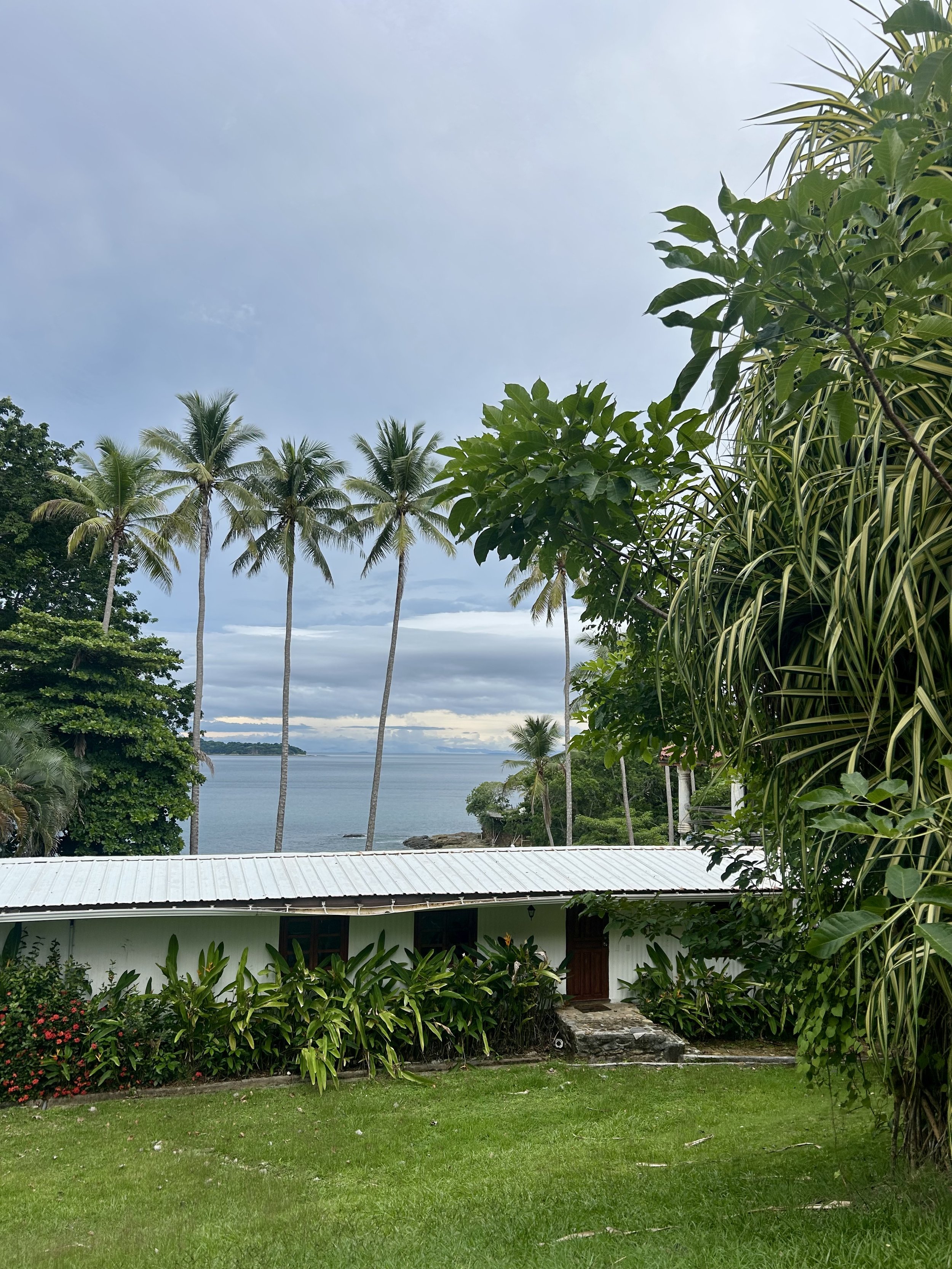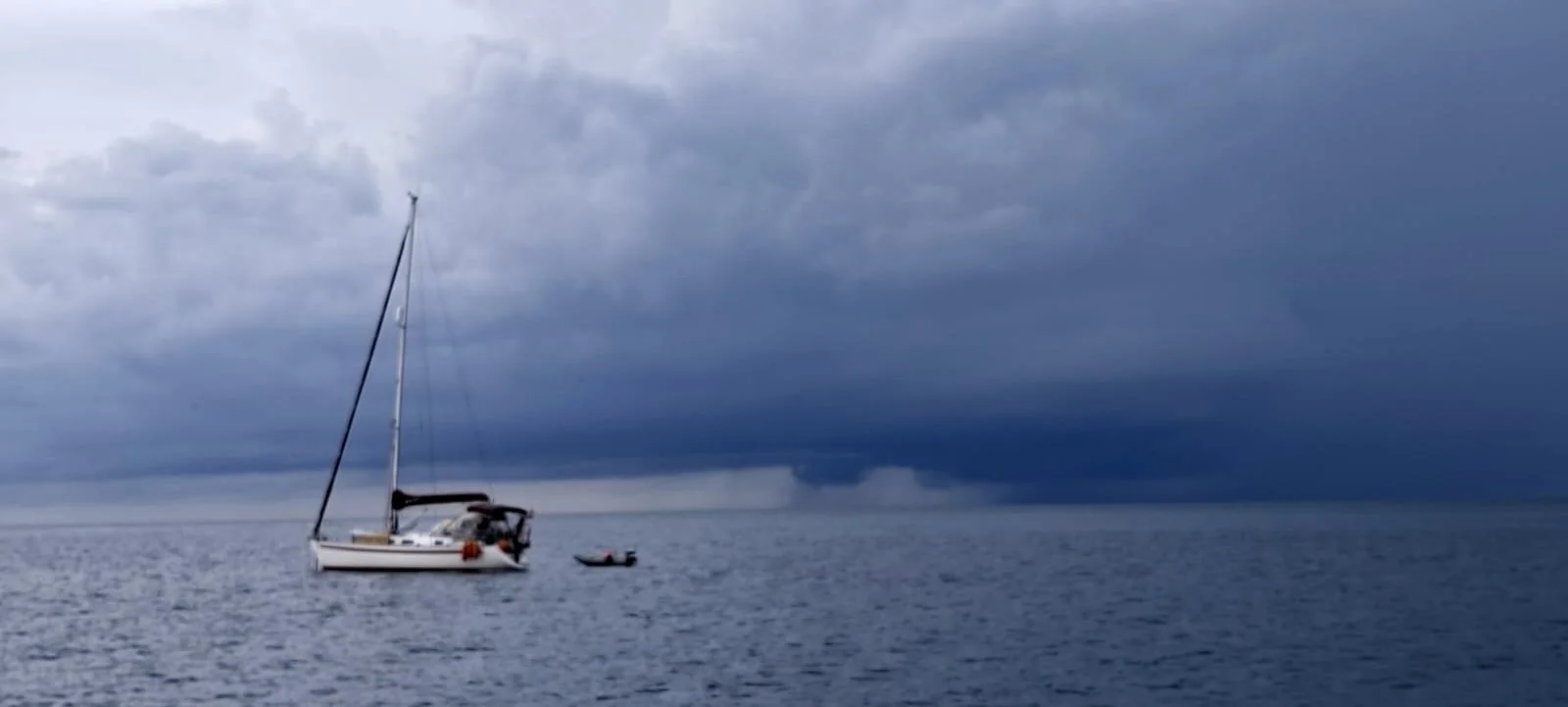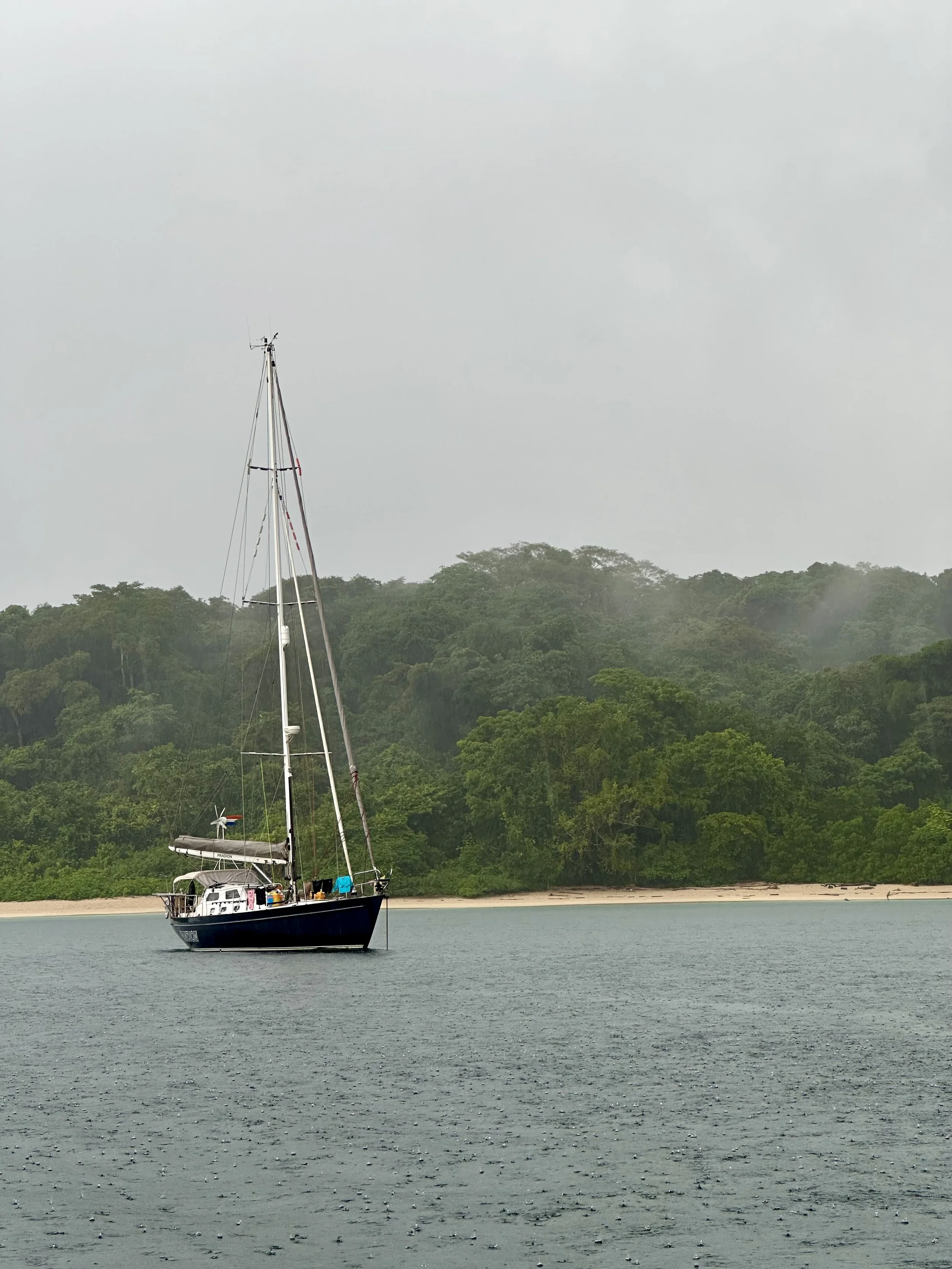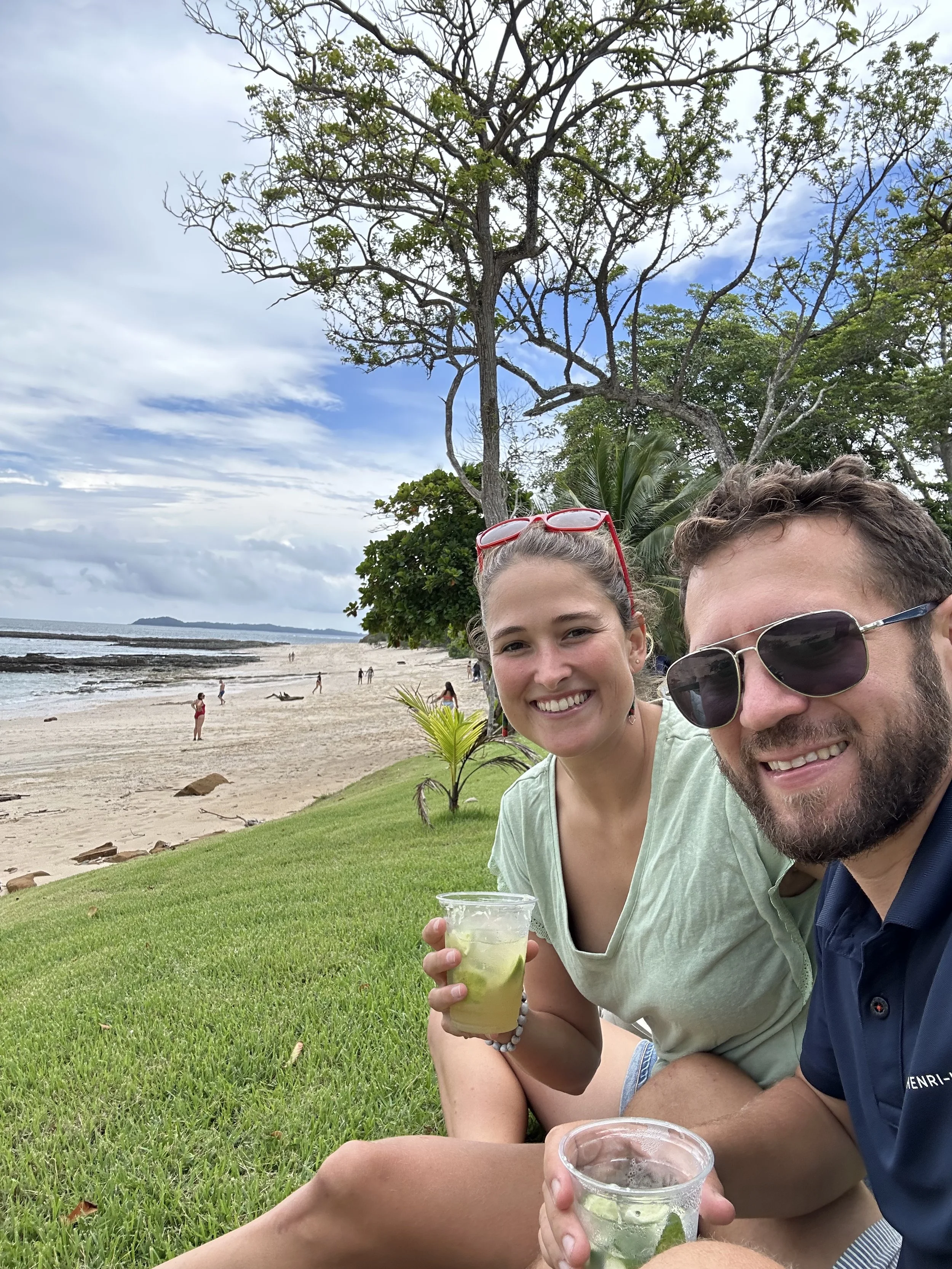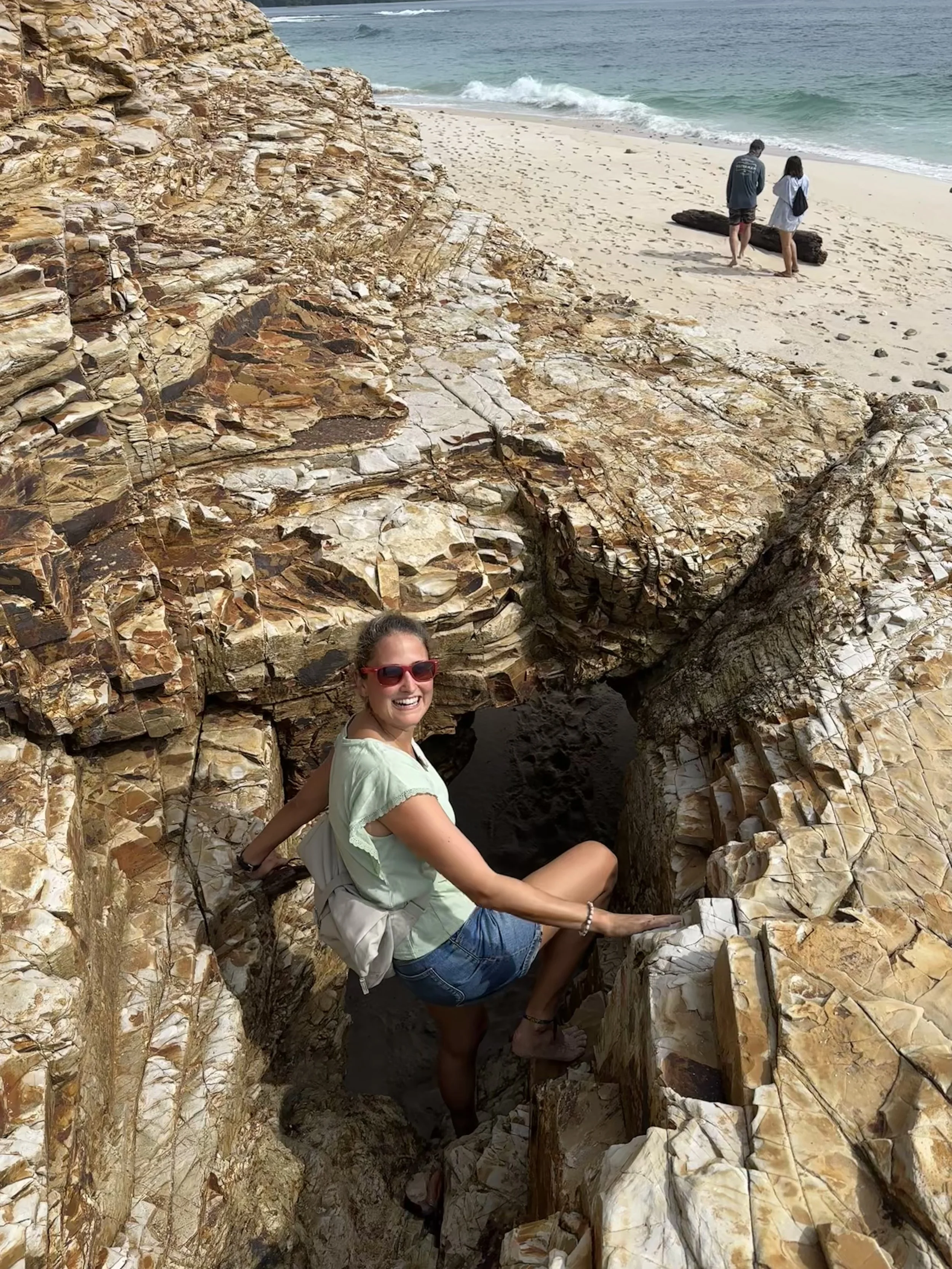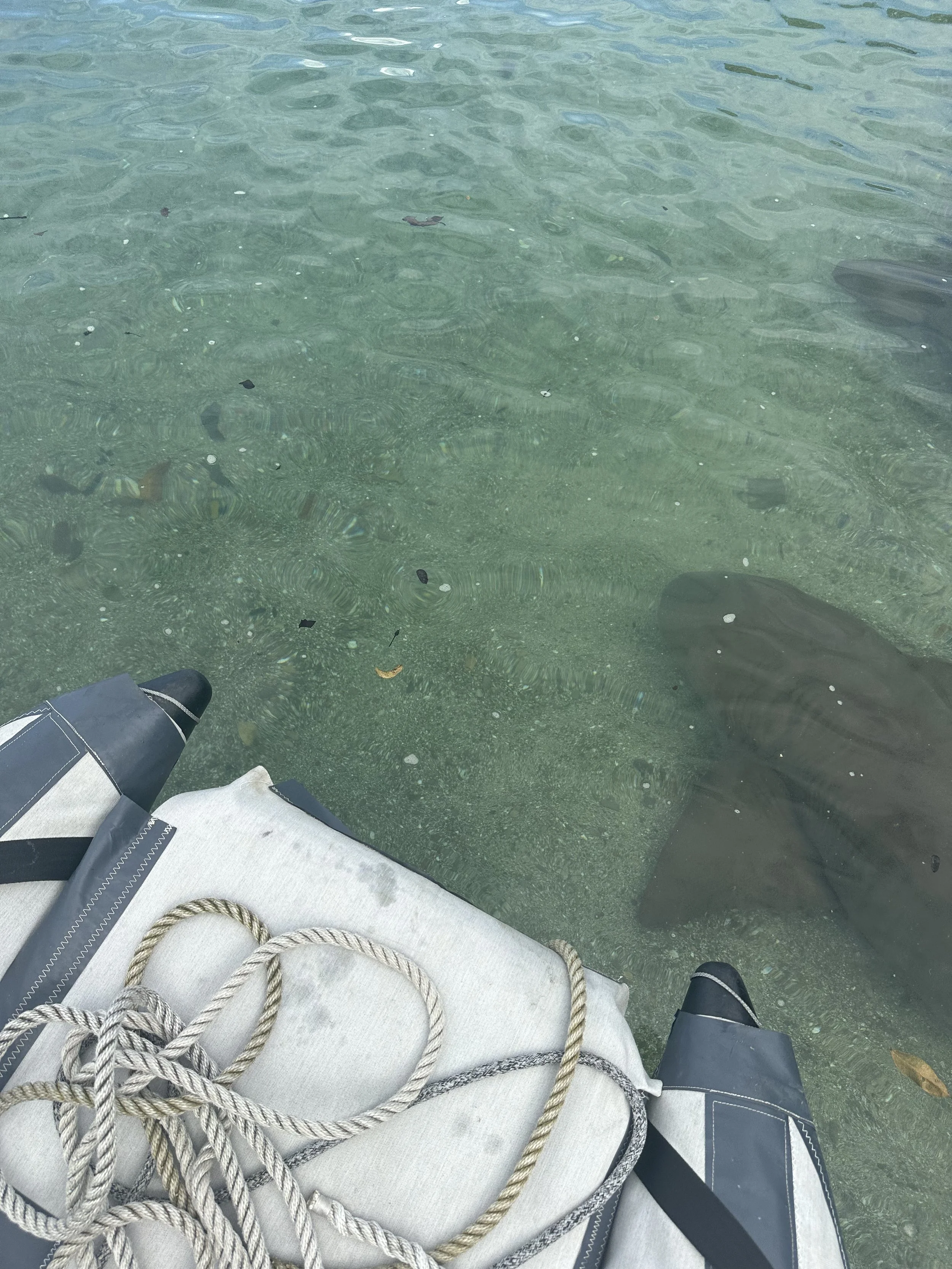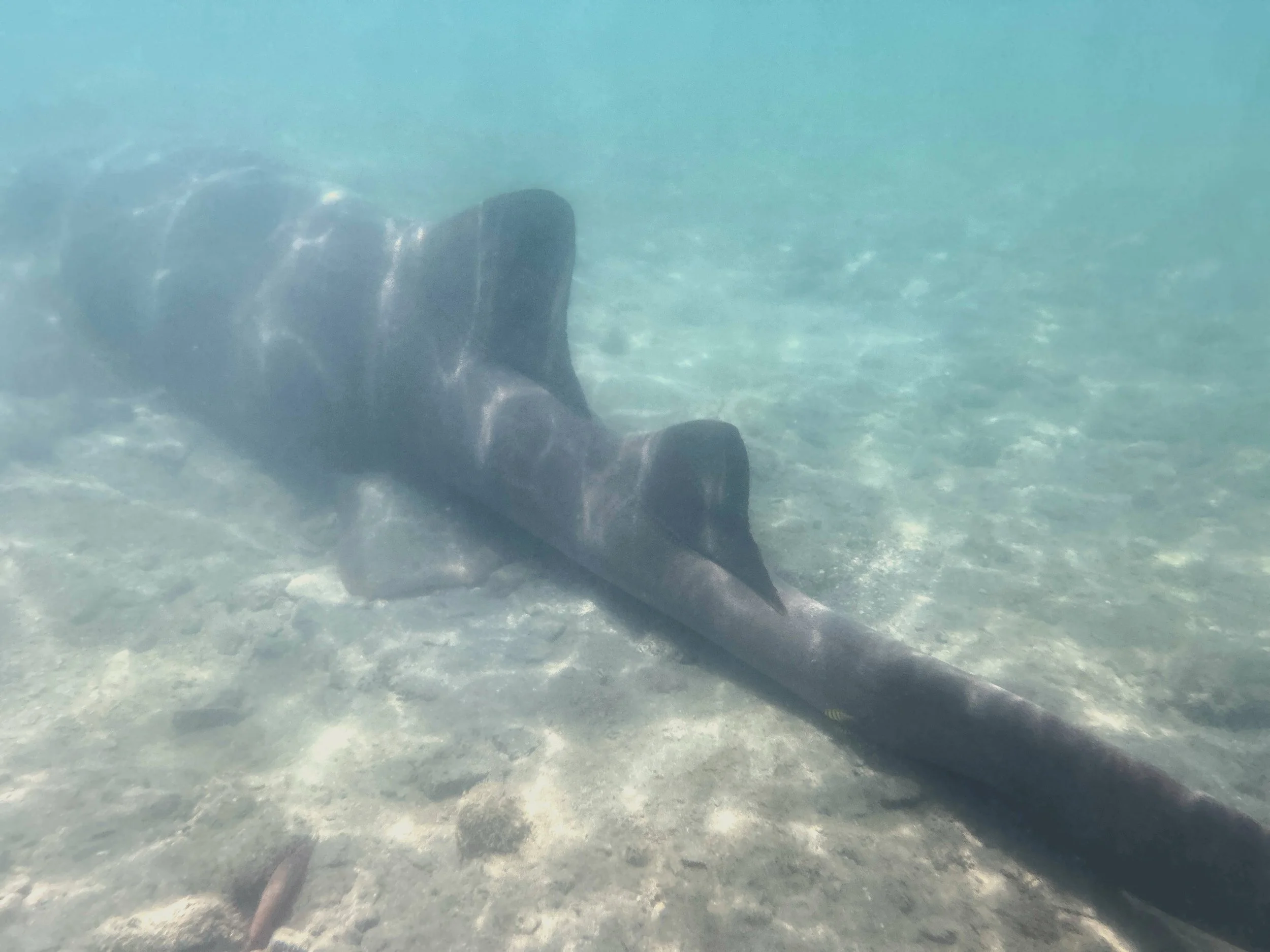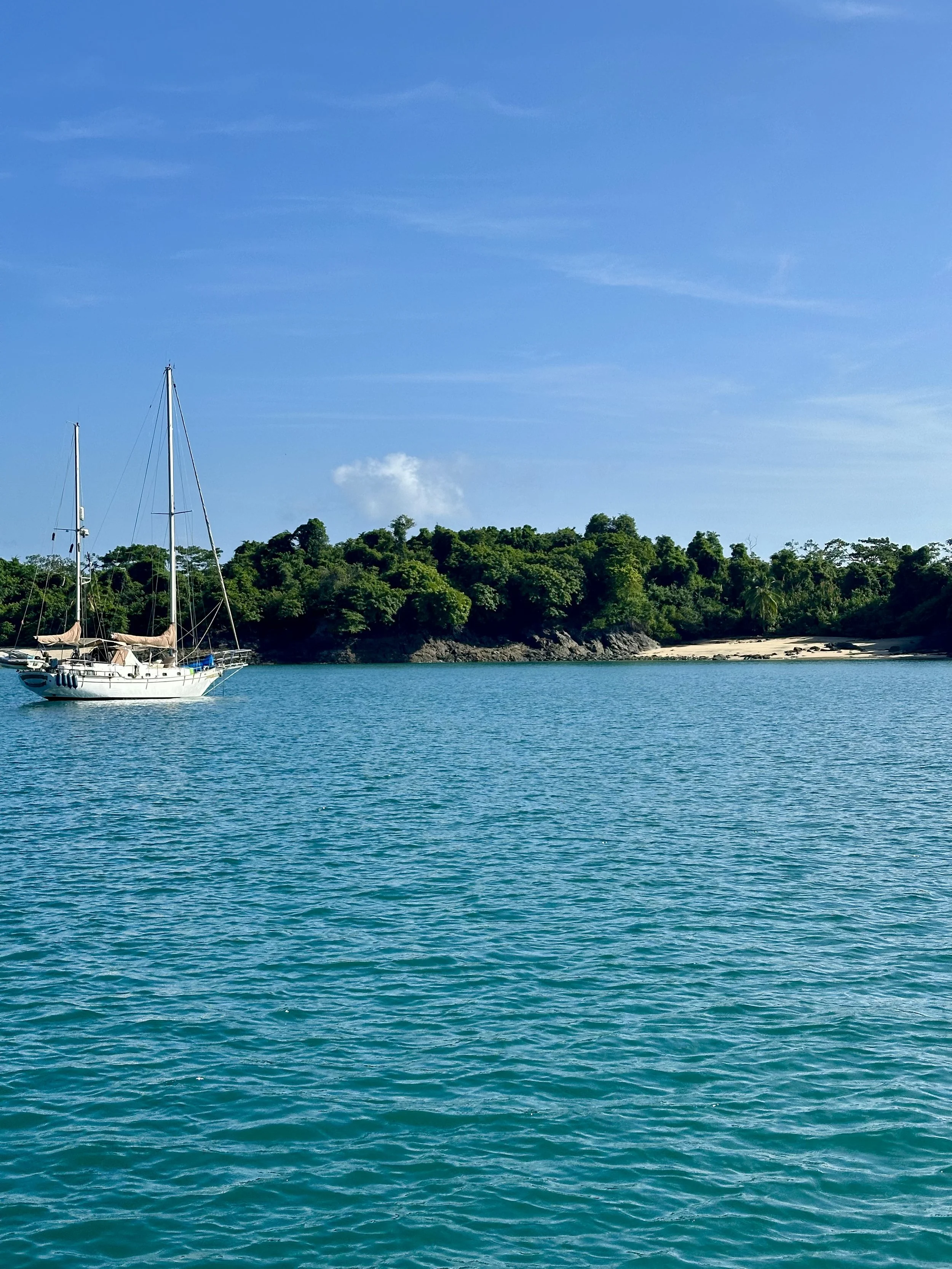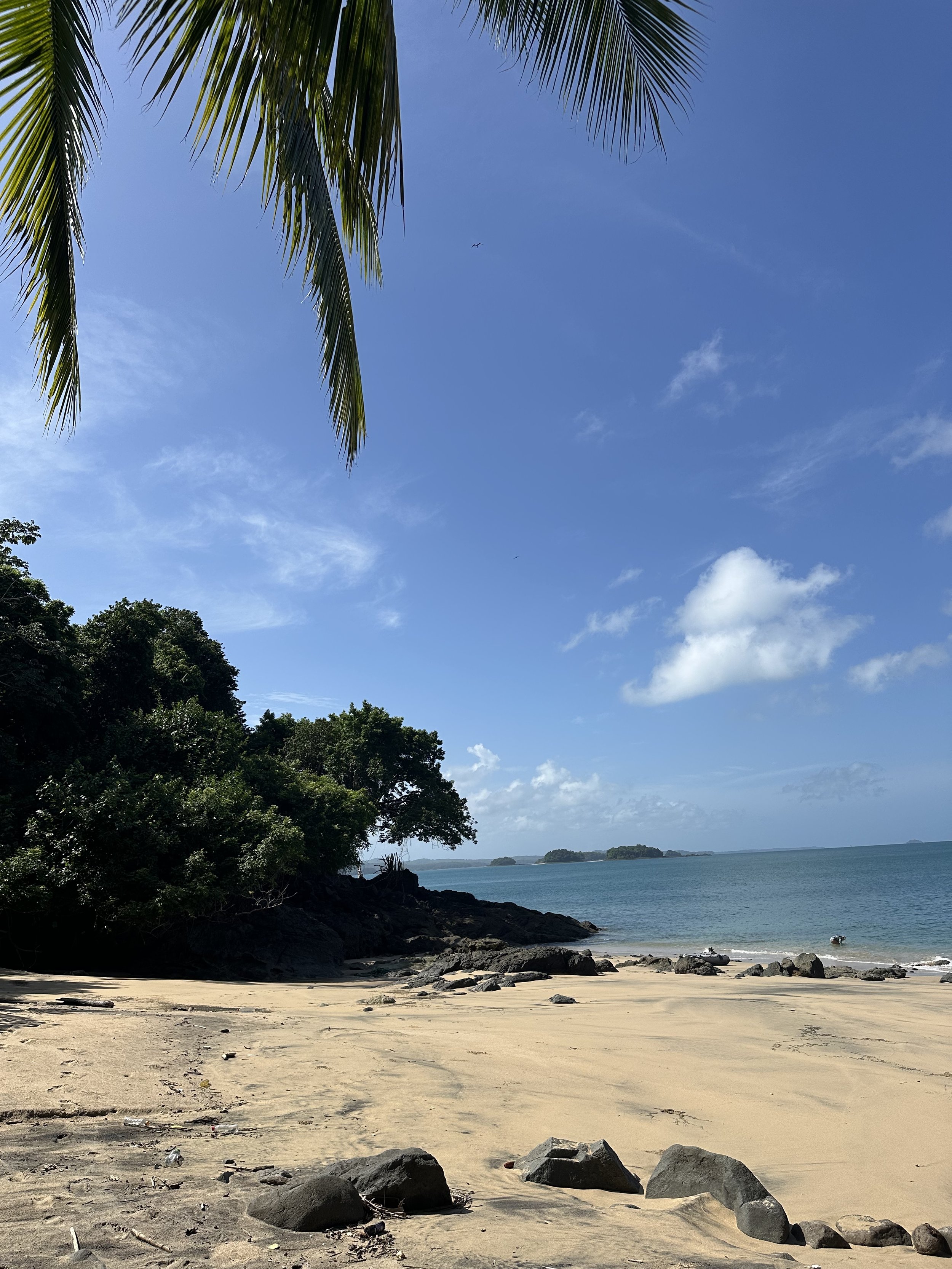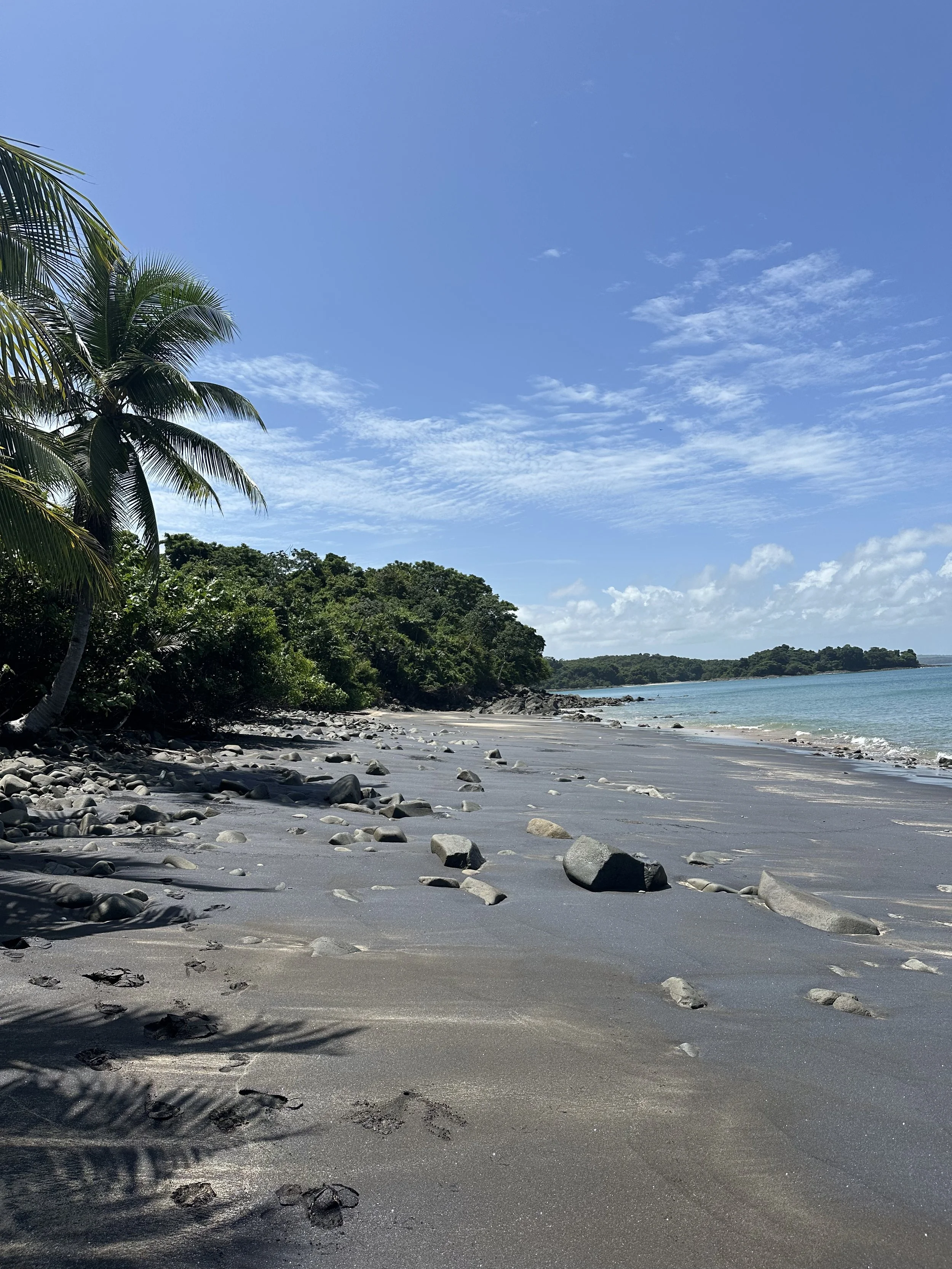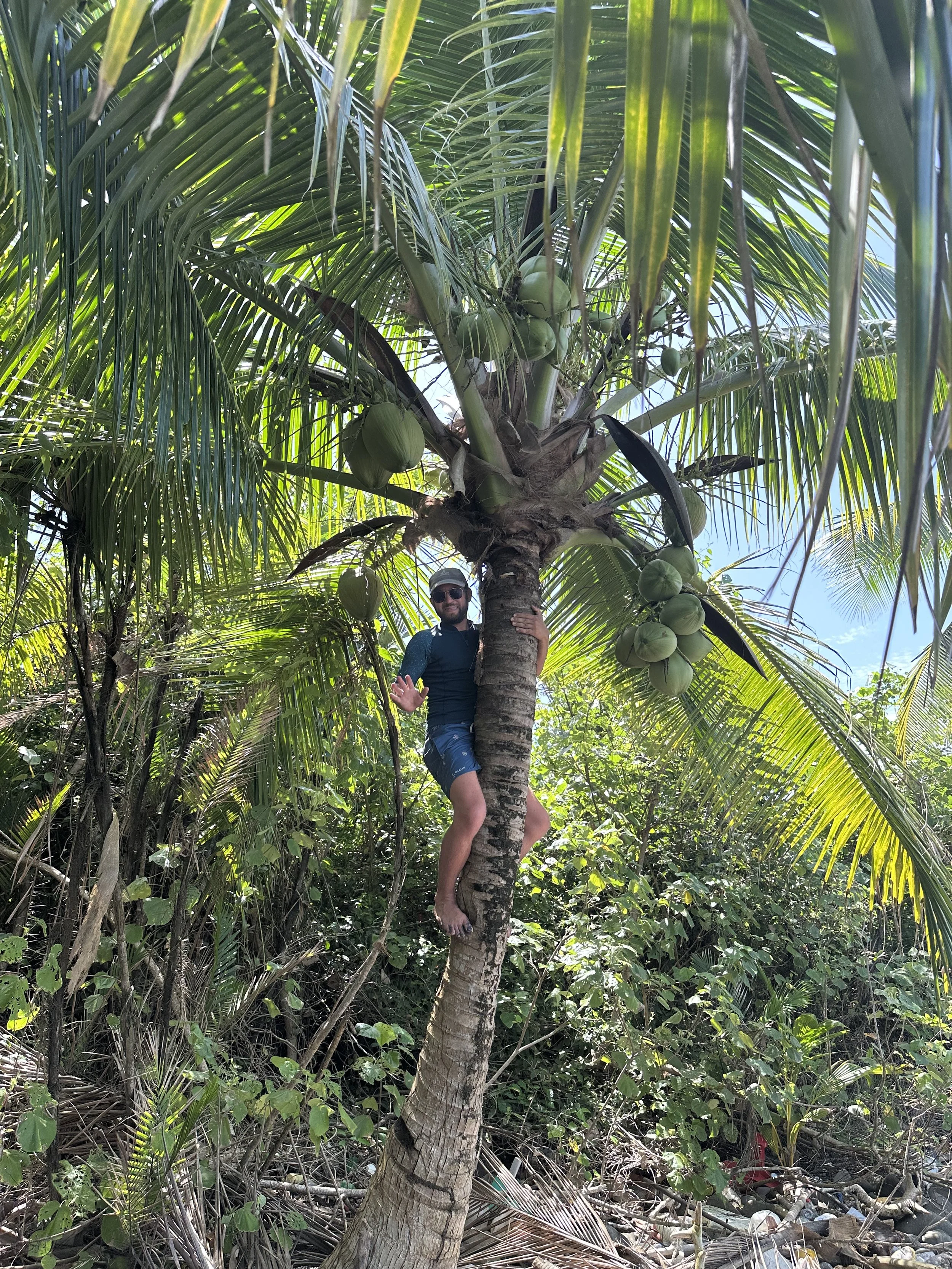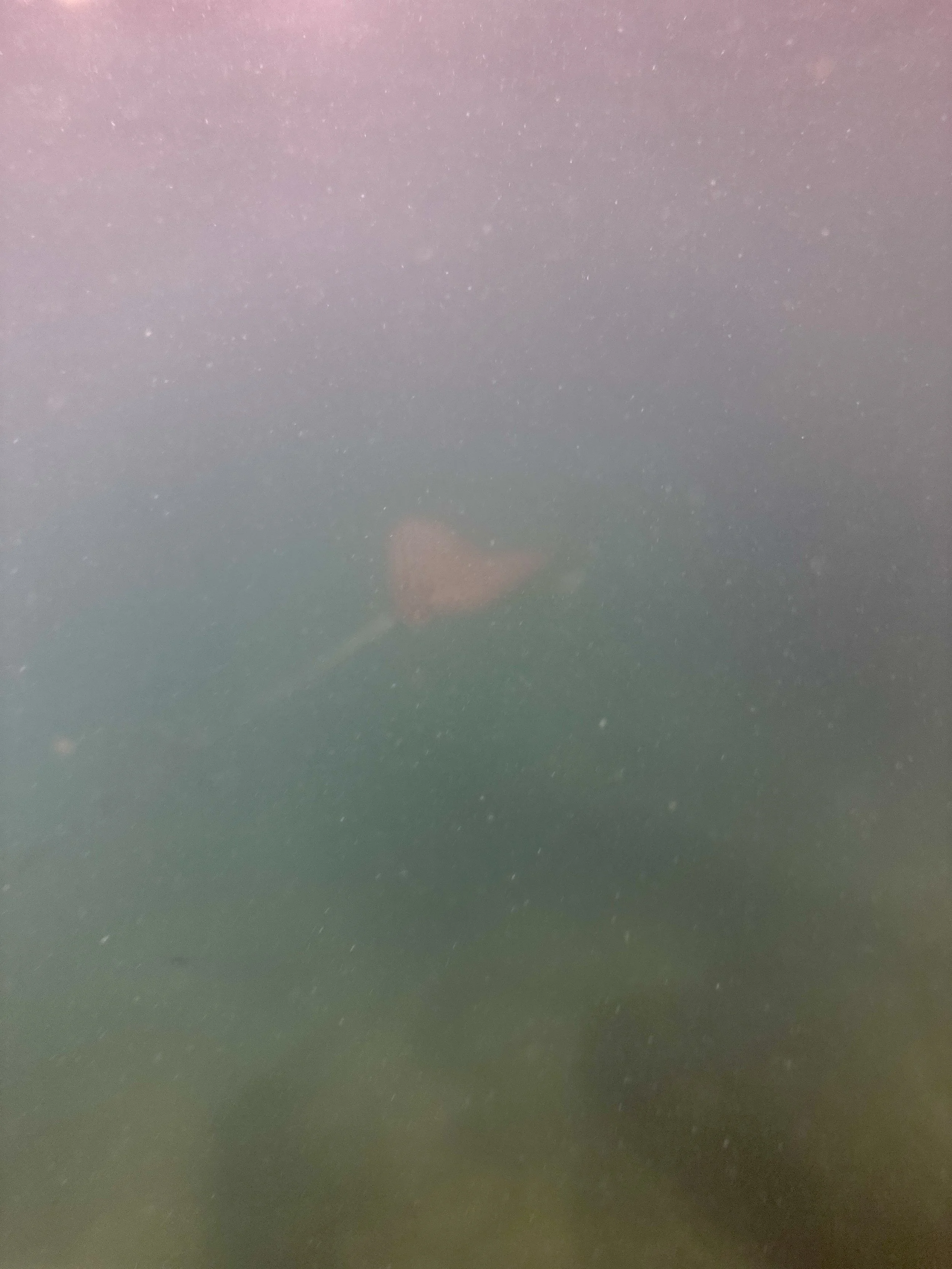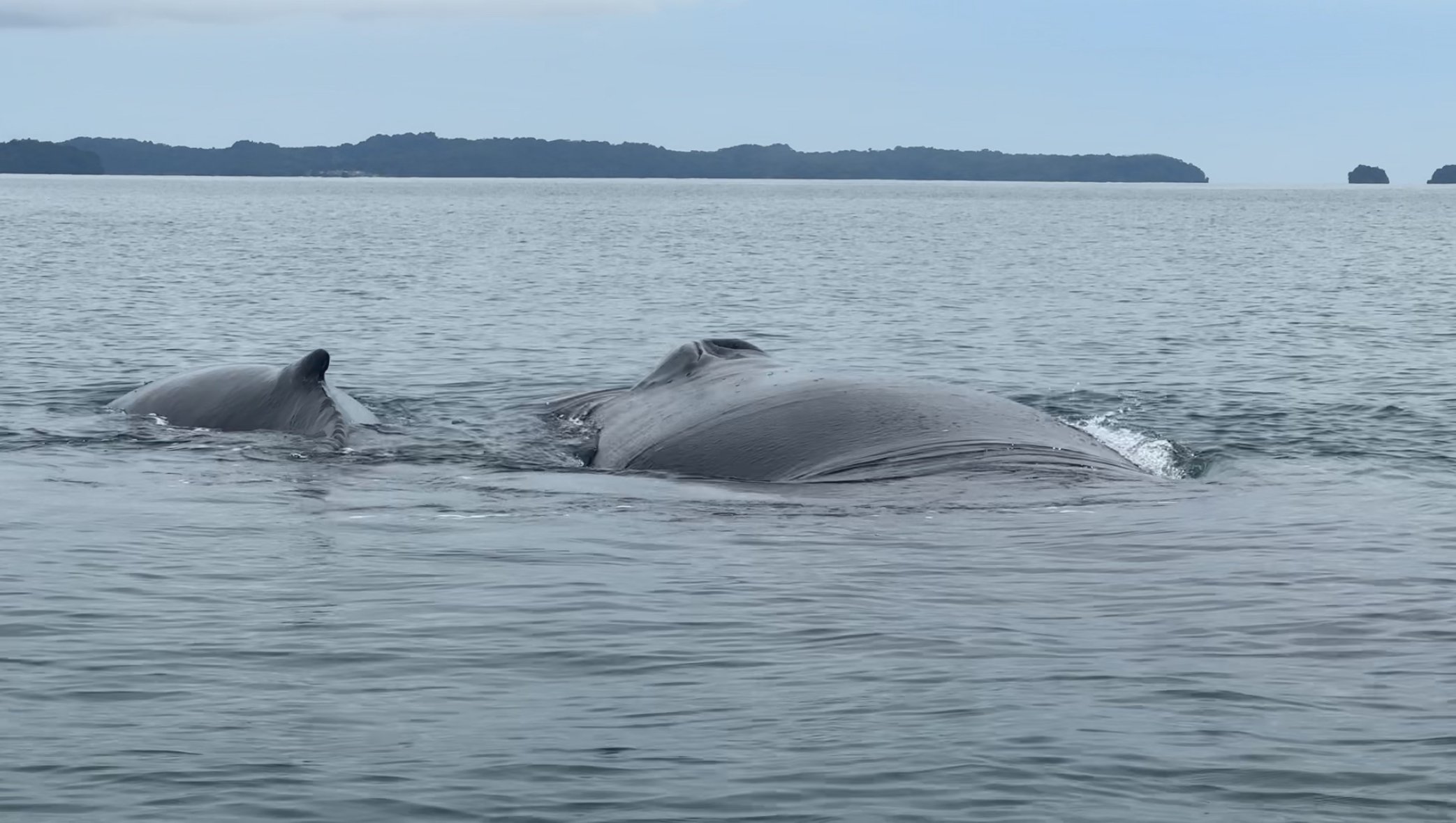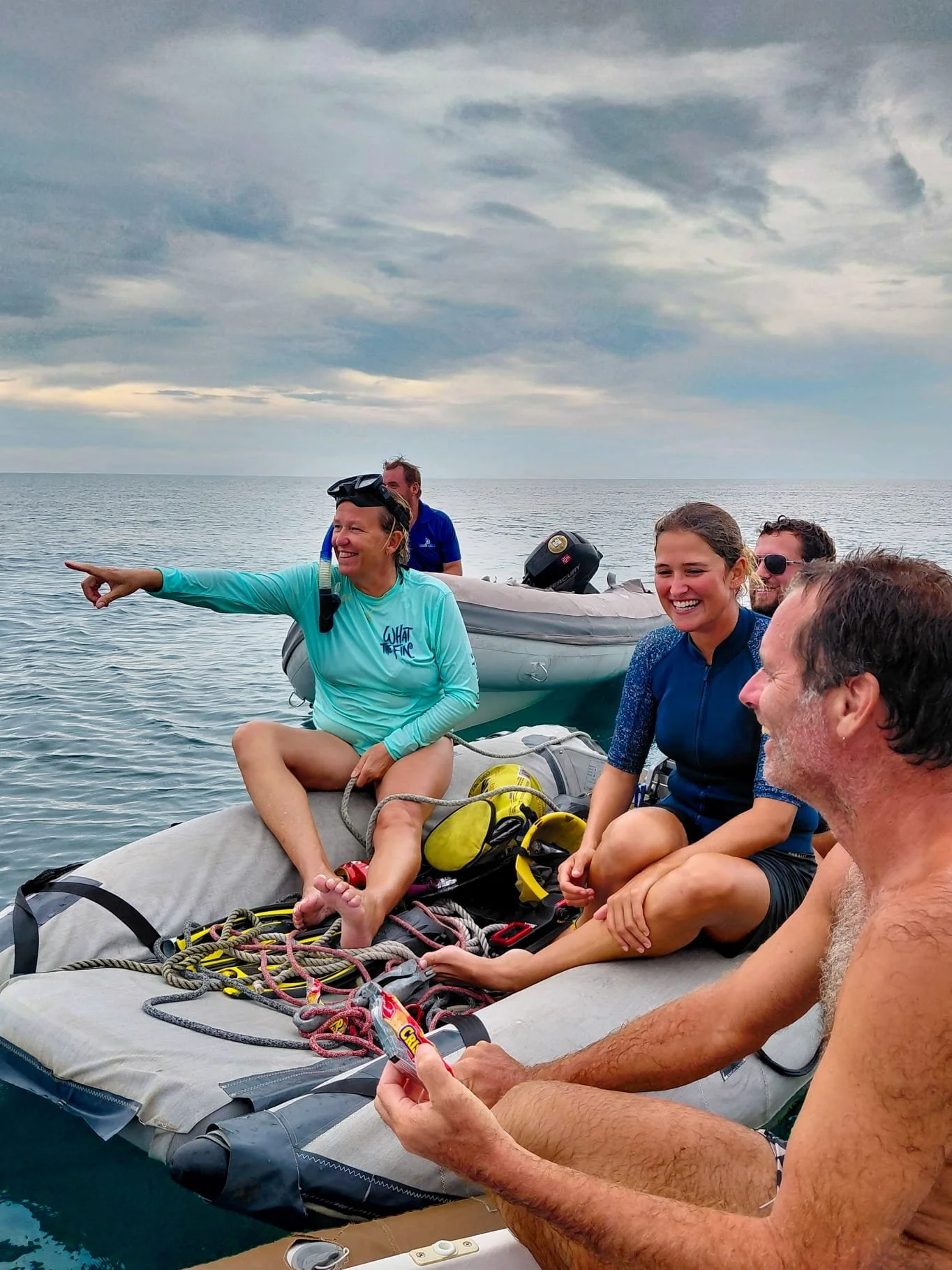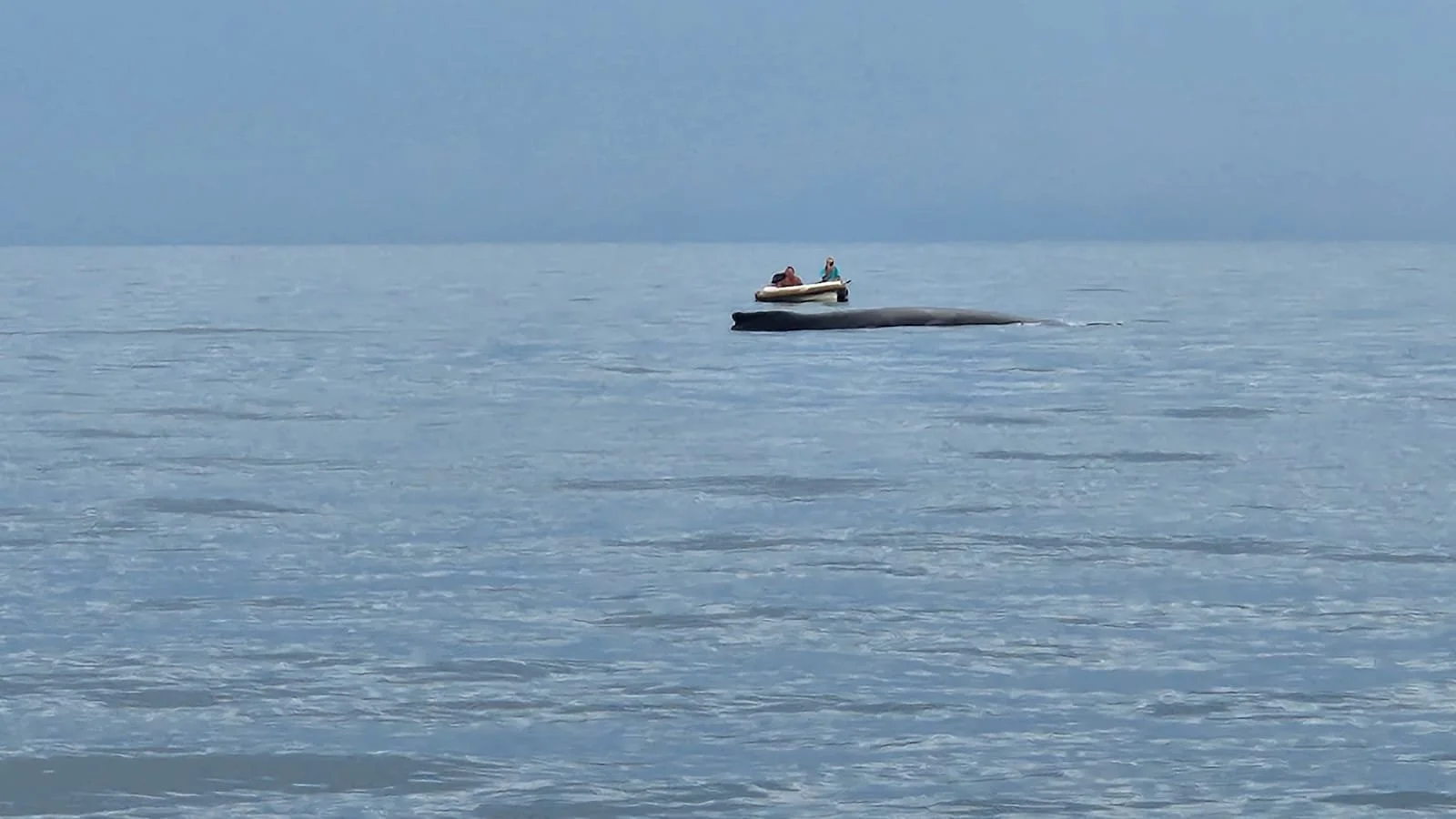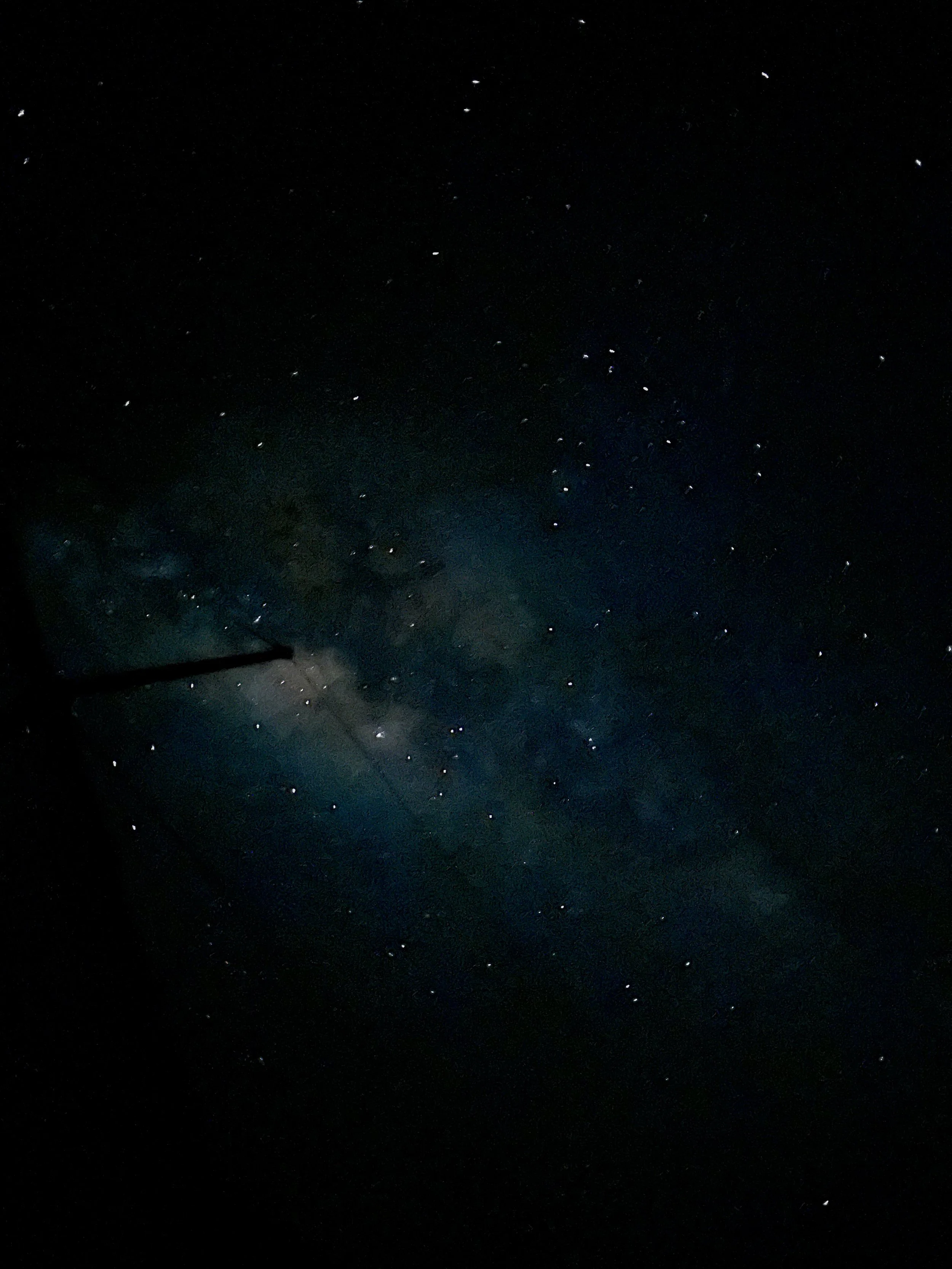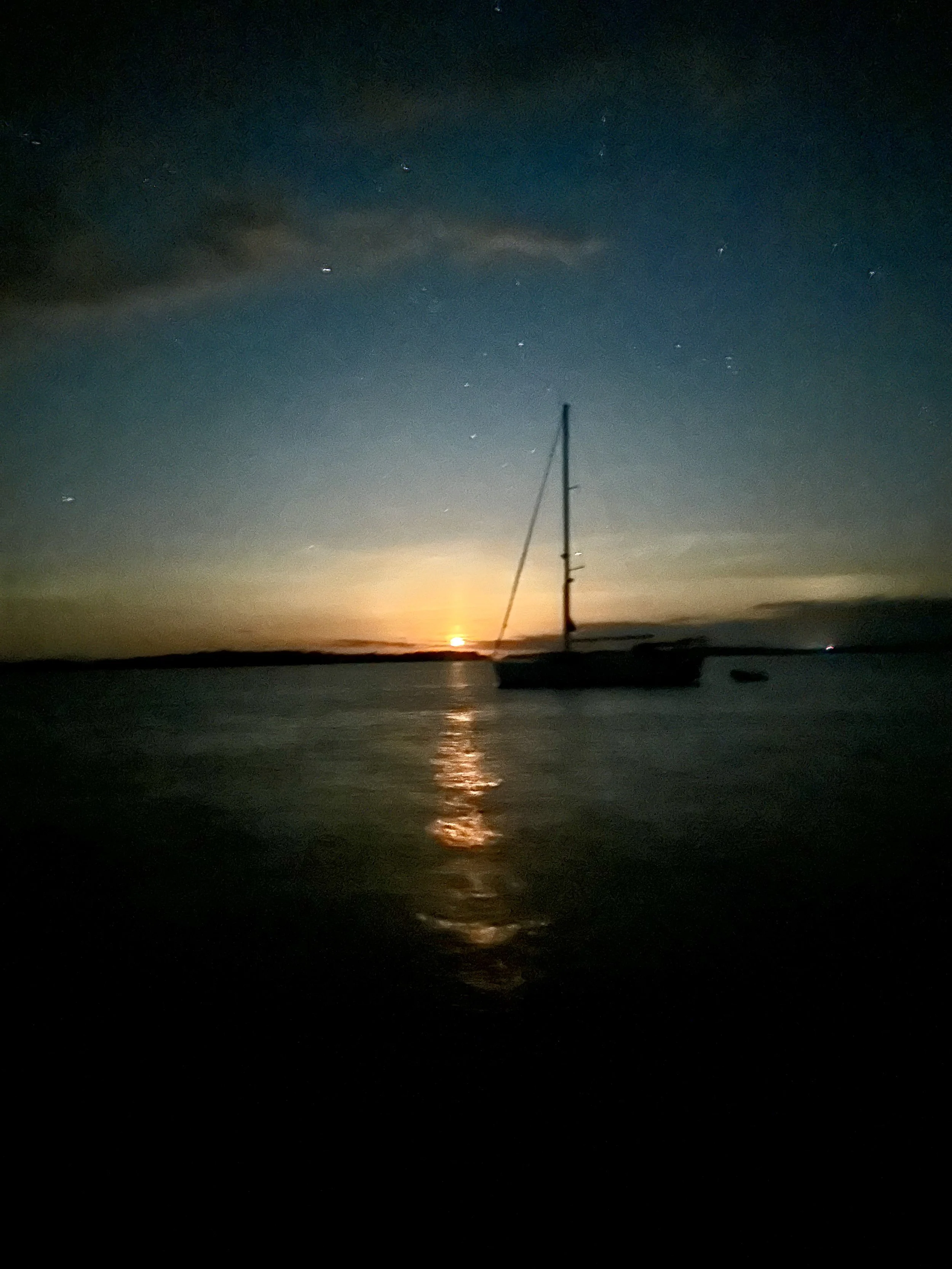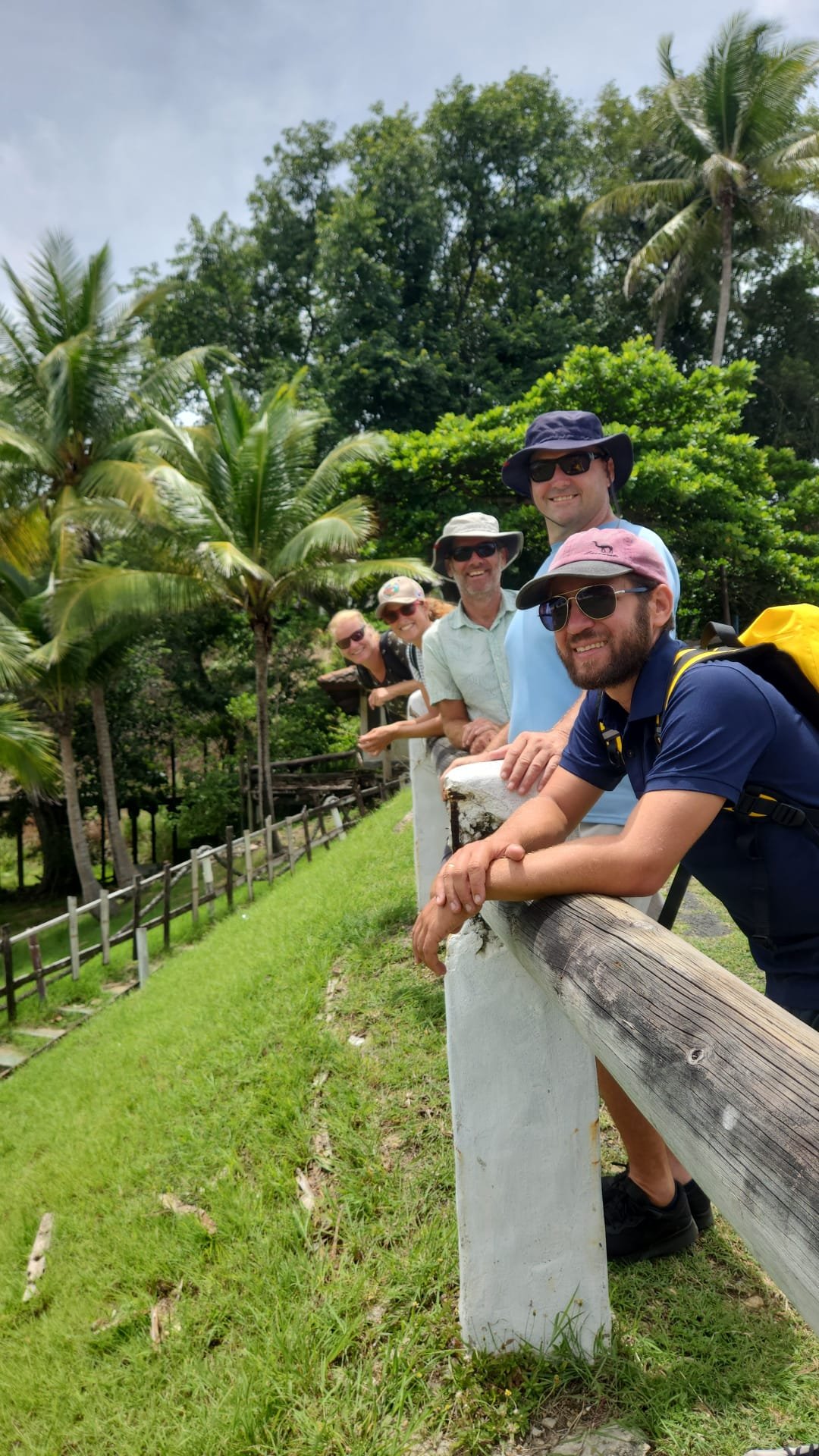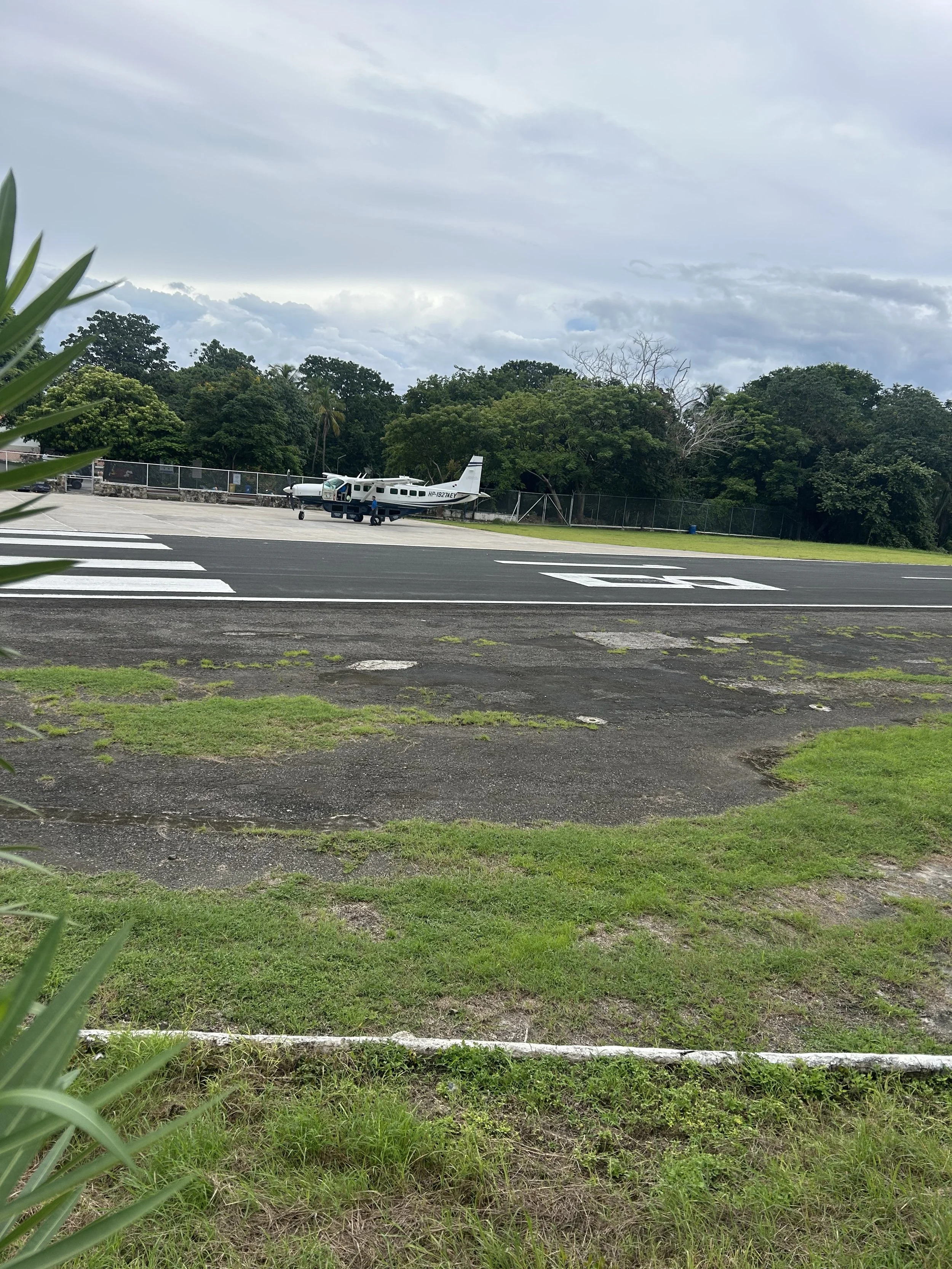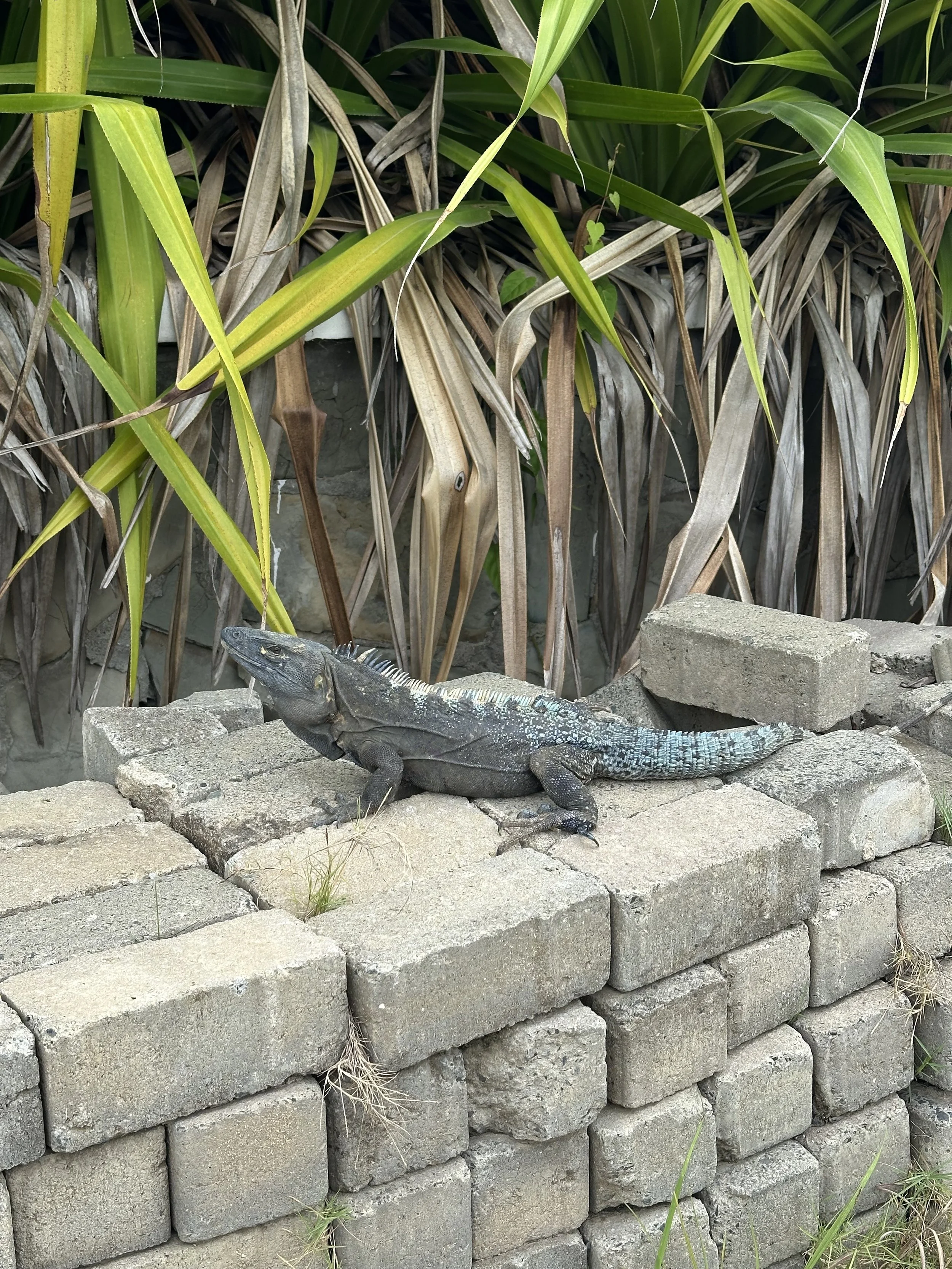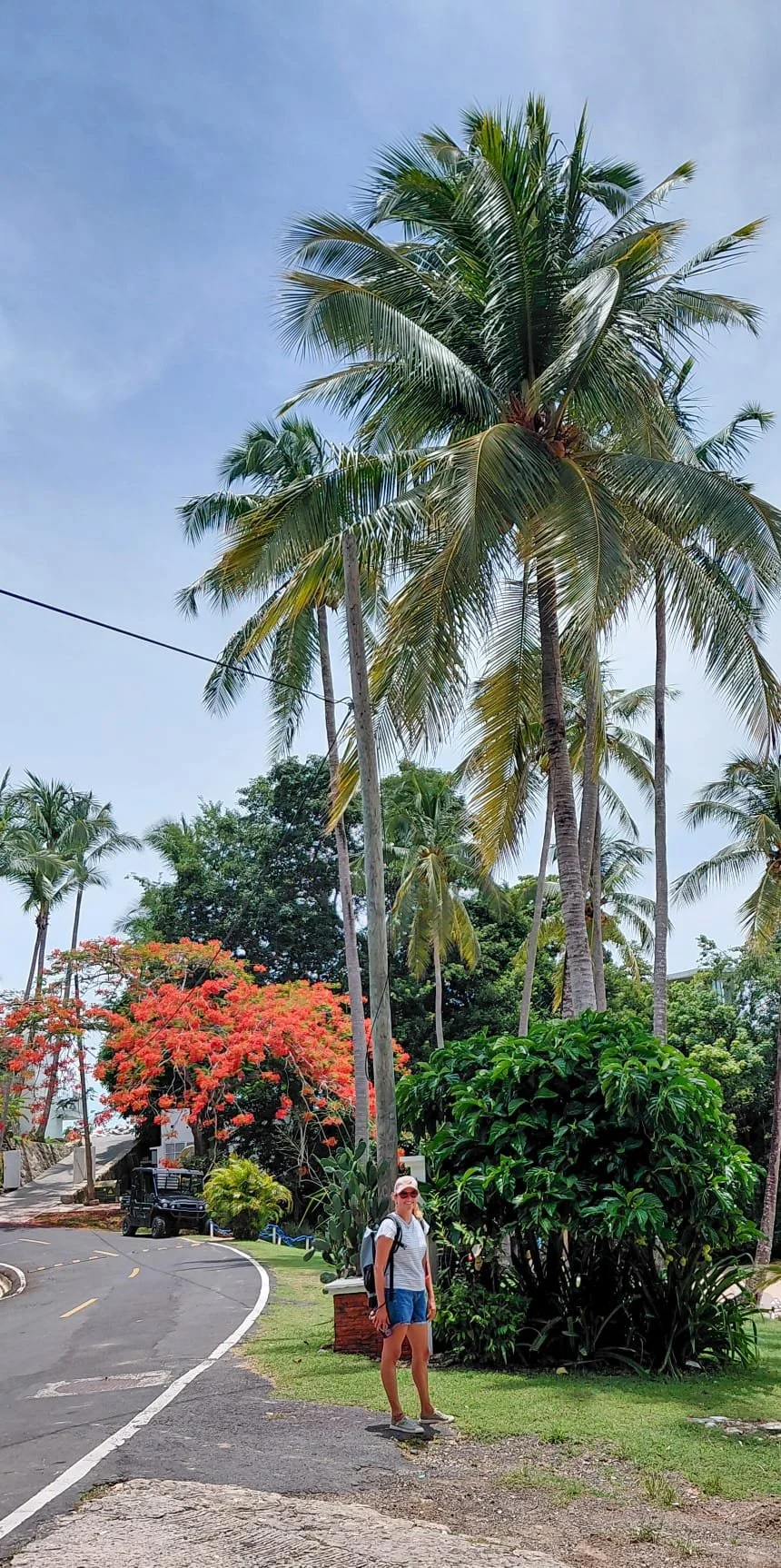Las Perlas: True sailing pearls
After three weeks in Panama City, we will head to the Las Perlas archipelago, 35 nautical miles away. There, a breathtaking natural world with secluded dream beaches awaits us. We will see whales up close, a beach full of sharks, fantastic trails through the rainforest and, of course, lots of great snorkelling adventures with fish, rays and turtles. The initial plan is to spend two weeks there until our spare parts for the rig arrive, but in the end we end up spending almost two months in the beautiful, unspoilt archipelago.
Pedro González
We sail to an island relatively far south, where our Dutch friends from Pandion and Choctaw are anchored. We arrive in the dark and anchor with five other boats – which later turns out to be quite lively – in a large bay. The tidal differences here can be up to 4 m, so you have to choose your anchorage carefully according to the prevailing tide level. During the day, we can see exactly where we have ended up. In a bay with lush green tropical forest and lots of coconut palms on a secluded sandy beach. In the middle of the island is a small wooded islet. The water around it is dark green but clean.
Our days on Pedro González turn out to be relatively wet. However, it rarely rains for more than a few hours, so we find enough windows to explore the island. As there is a hotel on the island, there are very well-maintained and even signposted hiking trails. One of them leads to a petroglyph – a stone with ancient engravings. As it starts to rain shortly after we set off on our hike and the days before have also been wet, it is quite muddy. The flip-flops that I (Peter) have chosen as hiking boots quickly fall apart because they get stuck in the mud. So I'm walking barefoot. You can feel the soft mud and stones under your feet, but with office feet like mine, you have to be a little careful where you step. It's an interesting experience that forces my fellow hikers to enjoy nature, as I'm not very fast. My wife has decreed that hiking boots are mandatory for the next hike. The second trail, called Garita, takes us along a narrow path through dense forest, interrupted again and again by small bridges and along small streams. We see huge branched trees and the dripping rain makes it an authentic rainforest hike.
The next hike the following day takes us first to a viewpoint in the forest called El Mirador, where we can look out over a beautiful bay. This time the weather is sunny, so the forest looks completely different. Along the way, we repeatedly encounter all kinds of birds, agoutis (small rodents) and even a dead iguana, which Henk almost steps on, giving him quite a fright. After enjoying a short break on the bench at the viewpoint, we continue on to Playa Galera beach on the other side of the island.
It feels a little strange to walk from one dream beach to the next, but we are not disappointed. Once again, a completely deserted bay with a beautiful beach awaits us. We find some abandoned equipment, such as a bar made from a tree trunk, torches and hanging lights, which are probably used for events here and there. There is a coconut palm tree, where we try unsuccessfully to get some nuts, and next to it a huge tree with a small portal in the middle that you can crawl through. On the way back, we walk once again through the narrow Garita path in the forest, which looks different in the sunshine.
We spend our evenings together with our sailing boat neighbours, sharing meals or sitting around a campfire on the beach, grilling steaks we brought with us from Panama. It's mango season right now, and there's a large tree just a few minutes behind the beach where we help ourselves. Unfortunately, the bananas on the bushes next to it are still too small. Otherwise, the surrounding area offers plenty of fish to keep us fed. The water on the Pacific side is significantly less clear than on the Caribbean side, but there are fish in abundance. Ciguatera (fish poisoning caused by bacterial toxins) does not exist on the Perlas, so you can catch and eat anything without worry.
When Henk and Caroline set off for Panama to stock up on provisions for their Pacific crossing, we are completely alone in the bay. One evening, the sky is clear and starry, and we sit at the bow with our seats, a bottle of wine and a fantastic view of a starry sky untouched by light pollution. Close to the equator, we can see both the Southern Cross and the North Star. We familiarise ourselves with the constellations of Centaurus, Scorpio, Virgo and Libra. What a wonderful last evening in Pedro González.
Mogo Mogo
Our next stop takes us to Mogo Mogo, an island about 14 nautical miles to the northeast. The crossing is a little difficult. The wind and current are coming from the north, and because of all the rain, all kinds of debris has been washed down from Panama's seven rivers. So one of us spends most of the time at the bow, keeping an eye out for the dangerously large tree trunks. We enter the bay we are heading for unscathed. Another sailing boat, which will leave us the next day, is also moored there. Mogo Mogo and the neighbouring island of Chapera, separated by a narrow channel, have a completely different charm. The water here is clearer and ideal for snorkelling. We see stingrays and Pacific cow nose rays around the boat, and the bay is shallow with turquoise blue water near the beach.
We take a trip to an even shallower bay south of our anchorage, which is no longer suitable for sailing boats with draught. Konstantin, an Austrian friend who has been living in Panama for more than 10 years, says you can find rays there. As soon as I get out of the dinghy into the water, I see four Pacific cow nose rays, but they quickly disappear. We snorkel up and down the bay twice. As it is not deep, the area is large. The visibility is a little better here, but you still can't see very far. We see a few large stingrays and, at the edge of the rocks, parrotfish and very large triggerfish. We no longer see the small school of Pacific cow-nose rays. The lonely beach invites us to explore. We swim over and watch the red crabs hurriedly flee in the same direction as we approach. The red creatures scurry sideways across the sand to their holes, keeping a constant eye on us as we approach. If you stay still long enough, they peek out of their shelters, only to hide again immediately when they see us. We sit on a washed-up tree trunk for quite a while and watch this spectacle. The hermit crabs are not so frightened. They run around on the beach in a wide variety of shells of all shapes, colours and sizes, and only when you get really close to them do they retreat into their temporary homes.
Our anchorage in Mogo Mogo is separated from the channel off Chapera by a shoal and a rock that is more or less visible depending on the tidal range. Around this shoal, we find a wonderful snorkelling spot. There are all kinds of schools of fish and a shy turtle. A little further away, there is even a field of bush coral. As we are already in the third week of our stay, our fresh supplies are pretty much exhausted, and the area around the rock offers plenty of suitable fish for harpooning to spice up our menu a little.
But we often don't need to swim far to discover the underwater world. Especially in the morning at low tide, the sea is particularly clear and Pacific cow nose rays, a large trevally, parrotfish, black-and-gold pilot mackerel and many other schools of fish frolic around our boat. For the first time, we also see inflated pufferfish here, and several times at that. They swim somewhat helplessly at the surface and can hardly steer with their tiny fins.
While we are anchored, we keep hearing loud, muffled noises. We immediately think of thunder, because thunderstorms are almost a daily occurrence here during the rainy season, even if they are often miles away and it is not raining where we are. But with the sky as bright as it is right now, that can't be the reason. Only when we look more closely do we notice the stone caves in the bay. Every now and then, a wave rushes into the cave, and the loud impact of the water on the rock in the cave sounds just like thunder. We decide to take a closer look. It is a fascinating natural spectacle and the colours are simply incredibly beautiful.
To stretch our legs a little, we drive to the beach. The strip of land here is very narrow, so you have access to the sea on both the west and east sides of the island next to a beach bar. There we collect a few of the fascinating pink shells and enjoy having the beach all to ourselves.
Contadora
We contact the dive shop in Contadora and arrange two dives. Contadora is the most populated island in Las Perlas. It is mainly home to the second homes of wealthy Panamanians, but also offers some basic amenities such as small supermarkets, diesel, restaurants and hotels. So we set off on the less than 5 nm journey to the southern anchorage, where the dive boat is to pick us up the next day. The wind is coming from the south and rocking us around quite a bit. Luckily, we only arrived in the evening and are leaving the boat early in the morning to go diving. We notice how calm we have been in the other bays so far. At 9 a.m., the dive boat picks us up with Guillermo and Tamara from Argentina. The two run a small dive shop from their home. We head for the northern islands of Pacheca and Pachecilla. Unfortunately, the weather is cloudy and the visibility while diving is relatively poor. The environment is similarly barren to what we experienced in Coiba and consists mainly of rocks. The current is strong in places. At least on the second dive we see a reef shark sleeping peacefully in a cave. As we always rinse our diving gear with plenty of fresh water and we only have a limited supply on board, we meet up with the Argentinians at their home. After washing our gear, we have coffee and a nice chat. Guille is visiting his daughter in Panama City and has to leave relatively soon.
As it is uncomfortably rough in the anchorage, we actually want to leave. We return to the boat to bring back our diving gear, then take out the rubbish and fetch shopping bags. We realise that leaving today could be stressful. We are also much calmer, so we decide to leave the next day. On the way to the supermarket, we arrange dinner with Tamara. We walk across the island through dense forest along a small road where motorised golf carts drive around. It is the vehicle of choice on the island. Between the trees along the coast, there are huge residences with magnificent views. Right next to the supermarket on the other side is the landing strip that crosses the island. It's Saturday and lots of small planes are taking off and landing to transport the wealthy Panamanians. In the supermarket, we find everything we need: a little cheese, fruit, vegetables and some beer. On the way back, we see deer walking through the forest and across the road. We stop at Tamara's, who makes us pizza, and spend a nice evening together until late into the night. We learn that the whales have arrived later than usual this year, but that there are increasingly more sightings.
Chapera
After stowing everything away again, we sail most of the way back, as we want to anchor in the channel between Mogo Mogo and Chapera. We anchor in 8 metres of sand in front of a deserted sandy beach – it's Monday and the weekenders from Panama City are gone again. Our Dutch friends Henk and Caroline are also back from Panama with their final provisions, and we make a campfire and barbecue on the beach. Unfortunately, there are tons of no-see-ums – 1-3 mm large blood-sucking mosquitoes – which dampen the otherwise perfect mood a little. We later learn that, according to the locals, the appearance of these pests has something to do with the phases of the moon. But it is certainly also due to the presence of wind.
Although we are less than 1 nm away from our bay in Mogo Mogo, it is different here. There are other snorkelling spots with lots of cauliflower coral and some turtles. The island is densely forested and there are no paths through the jungle, so the island is not ideal for hiking. However, the water in the channel is relatively clear due to the current, and you can enjoy fantastic snorkelling along the coast here.
Isla Bolaños
Konstantin, our Austrian friend, and his wife Marisela come to visit us on the Pearl Islands for the weekend. With their motorboat and as normal working people, they have a slightly faster pace. We break out of our slow routine and join them for a day. At noon, we head to Isla Bolaños, a small island with the Sony Island Resort. We meet Konstantin and Marisela there for lunch. While we wait for them, we visit the beach bar and drink two mojitos amid loud music. It feels a little bizarre to sit on the otherwise lonely and quiet islands among people and loud music with a mojito in the meticulously mowed lawn. The restaurant serves burgers and fish. Since we've had plenty of the latter lately, we decide on the burgers. We chat comfortably with Marisela and Konstantin in the hotel restaurant and with the waiters. A waitress tells us about her amazing whale sighting, and Konstantin also saw humpback whales on the way. Apparently, everyone has seen whales except us. July to November is whale season in Las Perlas. That's when whales from the south-east Pacific and even Antarctica come to the Las Perlas archipelago to mate or give birth to their young, so you can almost guarantee seeing humpback whales.
After lunch, we walk along the beach to some washed-up rocks. There, we can climb around a bit and enjoy the interesting landscape. Then we return to the boat and sail a few nautical miles to the next bay next to Ampón Island.
Ampón
Shortly before entering the almost completely enclosed bay, we are lucky enough to see whales. We see whales in the distance. It is a little too far away to follow the spectacle closely from the boat. It is our first encounter and we are fascinated nonetheless. We set the engine to idle and drift along to watch the spectacle for as long as possible. When we launch the drone, I realise that we are seeing a mother with her calf. For us, these are magical aerial shots.
Humpback whale with calf from above
The entrance to Ampón leads between two shoals, which are more or less well marked on the electronic nautical chart. However, the entrance is wide enough that this is not really a problem. Ampón is a particularly peaceful place to moor, as the islands of Casaya and Casayeta cover the west, north and south like a C. Ampón Island lies in the middle, with a few smaller islands surrounded by shoals to the east. The only downside is that rubbish sometimes collects here when the current drives it into the bay. This makes swimming here unattractive. In the evening, we are invited to a barbecue at Konstantin and Marisela's. There is freshly caught fish, meat, plantains and potatoes. We end the day in a relaxed atmosphere.
The next day, we take our dinghy to the bay southeast of Casaya. We want to look for fruit or coconuts on the beach. A little exercise won't hurt, and the battery of our electric outboard charges, so we paddle. Slowly we approach the beach – it's a good nautical mile we cover. The beach also appears completely deserted. Beautiful ochre-coloured sand, dense tropical greenery in the background, a single coconut palm in between. Mangroves grow on one side, just below the waterline. Suddenly we see something that looks like a ray. As we approach and are almost on the beach, we realise it was a shark. We slowly paddle after the shark. We see another one and then another. Gradually, we realise that this seems to be a recreational area for Pacific nurse sharks. They like to gather here during the day to sleep. At night, they go hunting. Sometimes there are up to 10 sharks in one spot in water so shallow that their dorsal fins stick out of the water. The sharks are over 2 metres long, unafraid and only take off at the last moment. What majestic animals. The tour of the beach proves to be less successful; apart from the annoying no-see-ums, we only find rubbish in the second row. There is only one coconut palm, but it is in the second row, which is out of reach.
Our good fortune continues the next day when we wake up to find a hummingbird on board, basking comfortably on one of our lines before flying away in a flurry of activity. Our Dutch friends Henk and Caroline from the Pandion set off on the long journey to the Marquesas. They will be at sea for about 30 days. We say goodbye to them – for now, because we hope to see them again there. Mickey and Sheila from the Lulu arrive, and we sail a little further south with them.
Isla Caracoles & Isla Majagua
We make a brief stop off San Miguel, the largest village in Las Perlas, because the Festival of the Virgin of Guadalupe is supposed to be taking place there. Mickey and Sheila, who arrived shortly before us, investigate and report that the village is not worth visiting. As the bay is not very comfortable and there doesn't seem to be any fiesta worth seeing, we decide on the spur of the moment to head for three small offshore islets that we noticed on the way and which are supposed to be great for snorkelling. As there is a north wind, we anchor in the south of the southernmost island (Isla Majagua), where we are quite comfortable. All three islands lie on a shallow sandy plateau that provides good protection at low tide. We quickly make our way to the small white sandy islet before it disappears under the rising water level. When we have finished taking the drone shots, we have to land the drone in the dinghy, as the island is now regularly being washed over by the waves. The subsequent snorkelling session is wonderful. We see huge schools of fish and lots of rays. Back at the boat, it is no longer so comfortable due to the rising water level. Mickey and Sheila are also in the opposite bay in Viveros, so we make the short hop of 3 nm there.
Viveros East
We anchor as close as possible behind the pier to be well protected from the swell. This works well and we have a quiet night. Viveros has quite a bit of abandoned infrastructure. A resort was supposed to be opened here once, but it didn't quite work out. There is an abandoned runway and the aforementioned pier, where we even see a pickup truck with people in it, so the island is not completely deserted after all. Sheila and Mickey set off to look for mangoes and are successful. Ines and I go snorkelling next to the small islands in the bay. On one side of the island, we can't see more than 2 metres, but once we go around, we find better visibility on the other side and some interesting corals with lots of fish.
Viveros South
Our second visit to Las Perlas takes us to the south-west of Viveros, together with Akko and Liza from the Choctaw. When anchoring, you have to be careful not to sail too far into the bay, as at low tide you can only see a few rocks protruding from the water. The whole area is quite shallow anyway, so it's easy to find a spot that's not too deep. There are several secluded dream beaches all around. Unfortunately, there is a swell coming into the bay from the west and the windless night is quite rocky. After picking a few coconuts on the middle black beach and quickly giving up snorkelling due to poor visibility, we head for the Platanitas Islands, only one nautical mile away.
Platanitas
We anchor in the southern bay and are much more stable. In front of us lies a miniature island with dense forest and a fine beach. At low tide, you can also hike to the neighbouring islands via exposed rock formations.
In the evening, we build a campfire with our friends Liza and Akko and barbecue the chicken we had frozen. Together with tostadas, beans, cheese, salad and chipotle salsa, it makes for a delicious Mexican dinner. The next day, we take the dinghy to the northern side of the island and to two small separate islets that rise out of the sea like mushrooms at low tide. Then the rock stump is exposed and the overhanging vegetation above it resembles the cap of a mushroom.
The landscape is impressive. Since visibility underwater in our anchorage is almost zero, we try our luck snorkelling there. Visibility is slightly better and we can see, or at least sometimes glimpse, fish and rays. On the second evening, we enjoy a sundowner beer on the north beach of our island. There are no-see-ums right by the forest, but the water is still low enough that, with the right timing, we can quickly escape the waves and flee to a small neighbouring rocky island. There, we watch the sea snails on their migration and enjoy our evening cold drink without any pests.
Bayoneta
Our next stop is at Bayoneta Island. Deep in a well-enclosed bay, we lie as if on a lake. On the way to snorkelling, we see humpback whales not too far away. So we decide on the spur of the moment to approach them carefully with the dinghy. The whales are completely unimpressed by us and our dinghy, and we catch a glimpse of these magical giants up close. They surface leisurely to breathe, usually 3-4 times, making their characteristic hump, before diving down again for quite a while.
After a while, we head for our actual destination, the beach west of Bayoneta. There we meet the crews of the other two boats – Liza and Akko from the Choctaw and Lisbeth and Andreas from Alissa – with whom we are travelling. Our dinghy is quickly transformed into a floating bar, and so we stand in the water for a while and drink white wine. I take a short walk along the beach, which is unfortunately littered with all kinds of rubbish. I come back with a yellow construction helmet as a souvenir. In the distance, I see a whale slapping its tail fin powerfully against the water. The spectacle repeats itself several times and, together with Ines and Lisbeth, we set off in our dinghy to get a little closer. The tail fin slapping stops, but we still get a little closer to the whales. Again and again, the whales appear very close to us. In the meantime, Akko, Liza and Andreas have also come out to us with the other two dinghies. We can even hear the whales singing while sitting in the dinghy – normally we only hear this underwater. We are completely fascinated and watch the spectacle together for a while before we jet back to our anchorage in Andreas and Lisbeth's dinghy – we are back at the boat just before sunset.
Bayoneta Bay has hardly any light pollution – perfect for observing the Perseids. So we make ourselves comfortable on deck and look up at the sky. Contrary to expectations, we hardly see any shooting stars, but we do see the Milky Way and all kinds of constellations – from the North Star to the Southern Cross. The rise of the full moon that evening was also remarkable, almost resembling a sunrise.
The following nights we have no-see-ums on board and it is hot and completely windless, so we soon set off again for Contadora to get some fresh provisions.
2nd visit to Contadora
We return to Contadora with our buddy boats Choctaw and Alissa. During this visit, we hike around the island. We land in the south at the airport ferry and dinghy dock. We pay USD 10 to leave the dinghy there for the day. As there are six of us, we accept the price, although we hear that it is sometimes only USD 5. From there, we hike along the airfield in the east to an abandoned resort. We walk along the beach, circle the airfield and buy some fresh food at the supermarket.
We continue along the paved road across the north of the island through populated areas towards the west of the island. There we dine in a Colombian restaurant before heading back south towards the airfield and ferry/dinghy dock. We see different types of dwellings, simple cottages and ostentatious villas, lots of deer and dense vegetation. After weeks without civilisation, it's a very welcome change.
Conclusion
We will soon be flying to Austria for a wedding and will leave our boat in Vistamar Marina. Before that, we will make a short stopover on the other side of the Gulf of Panama on the Islas Otoque. Our stay on Las Perlas was significantly longer than originally planned, but this allowed us to explore an almost untouched sailing and nature paradise – except for the now ubiquitous problem of rubbish. Las Perlas invites you to explore and surprises you with magnificent nature, dream beaches and secluded anchorages. We don't regret a single second of our unplanned stay.
Useful tips:
Weather
The wind and weather in the Pearl Islands is characterised by a convergence zone. There are thunderstorms almost every day, and during the rainy season – known as winter by Panamanians – from May to November, there is regular rainfall, albeit significantly less than on the Caribbean side. It usually rains in the afternoon or evening. It rarely rains all day, and we also experience several consecutive days of sunshine with no rain at all. There are hardly any constant winds, except when the trade winds from the Caribbean side make it across the isthmus, then there are longer periods of constant north wind.
Snorkelling
In our experience, visibility is better on the northern islands. The three small islands off Viveros are an exception. Visibility often varies from day to day. Our favourite spots were:
Mogo Mogo, the small island towards Chapera.
Chapera in the south-east.
Isla Caracoles/Isla Majagua: Between the islands at low tide, you can find lots of fish and rays.
East of Ampon: The visibility wasn't so good here, but there were some interesting fish there.
Hiking
Pedro Gonzalez is by far the best place for hiking. There are some very beautiful hiking trails there. You can go for walks on Contadora, and on Isla Bolanos/Sonny Island you can also venture a little way into the interior of the island. Most of the other islands are quite wild and you quickly come up against a dense wall of vegetation.
Restaurants
There are several restaurants on Contadora offering a variety of cuisines and price ranges. On Saboga, there is a pizzeria that has been recommended to us several times, but we have never been there ourselves. Further south, you will find the resort restaurant on Sonny Island or on San Jose.
Whale season
The whale watching season officially runs from July to November, when the humpback whales arrive in the area. From mid-July onwards, we can confirm this and it is almost guaranteed that you will encounter these magical giants.
Our favourite spots
Mogo Mogo/Chapera: Depending on the wind, in the south of Chapera or in the northern bay of Mogo Mogo. There you can enjoy wonderful snorkelling and find beautiful beaches.
Ampon: Between Ampon and Casaya, it is usually exceptionally calm. You can find nurse sharks on the beach there, which is an absolute highlight.
Isla Caracoles/Majagua: Unfortunately, there is no very good anchorage spot there, but it is a miniature paradise. There is a small rocky island with vegetation and birds, a beautiful sandy spot and the best snorkelling spot in Las Perlas.
Pedro Gonzalez: In the bay of San Bernardo, you are surrounded by greenery and a dream beach. From there, you can explore the island's hiking trails, the most beautiful in Las Perlas.



